-
Ukraine shows footage of Bober drones hiitting Russian air defenses, fighter jet in Crimea
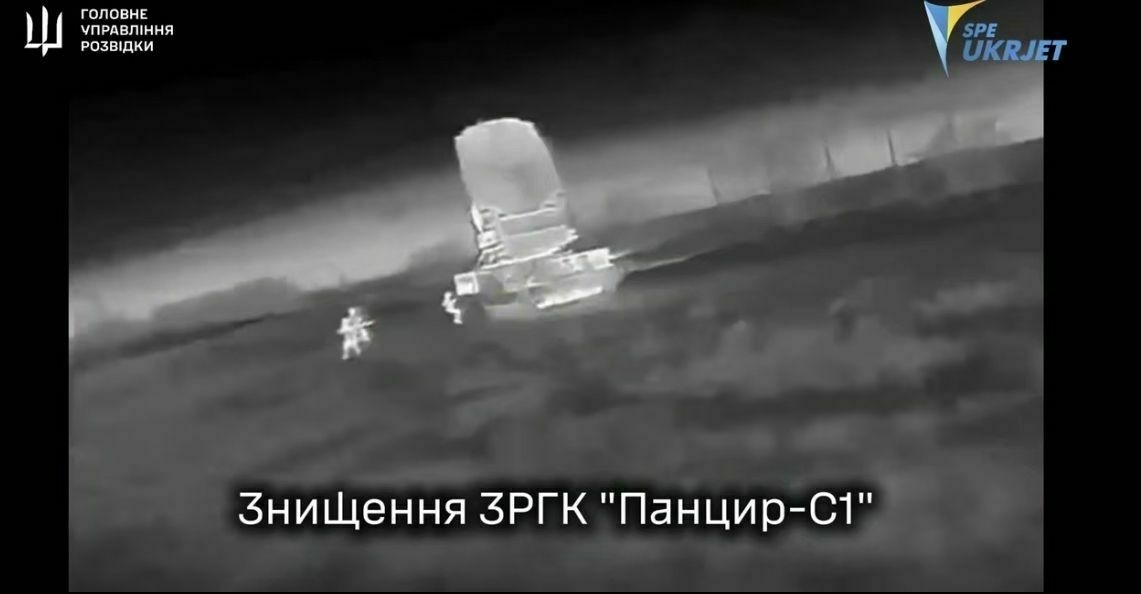
Ukraine’s military intelligence agency (HUR) released on July 1 video footage showing domestically produced drones striking multiple Russian air defense assets and a fighter jet in occupied Crimea in what it described as a successful special operation.
The undated footage shows the combat use of UJ-26 drones, commonly known as Bober (Beavers), targeting high-value Russian military systems.
“These reliable weapons in the hands of HUR special forces are turning critically important Russian targets into useless scrap,” the agency said in a statement.
HUR added that the Bober drones are effectively “gnawing through” Russia’s expensive air defense systems “like barberries."
0:00/A Ukrainian drone targets and destroys Russian military assets in occupied Crimea, according to Ukraine’s military intelligence agency. (HUR / Telegram). The released footage shows that the strikes destroyed or severely damaged several Russian military assets, including a Pantsir-S1 air defense system and its crew, a Niobium-SV radar, a Pechora-3 coastal radar, a Protivnik-GE radar, and a Su-30 fighter jet stationed at the Saky airfield in occupied Crimea.
The Kyiv Independent could not verify HUR’s claims.
The strikes are part of Ukraine’s ongoing efforts to degrade Russian military capabilities in Crimea, which has been under Russian occupation since 2014. Moscow reported Ukrainian drone strikes against the peninsula earlier on July 1, with the Crimean Wind Telegram channel reporting attacks in the vicinity of S-300/S-400 air defense systems.
Ukraine has increasingly deployed new drone systems to target Russian military assets on the front line and deep inside the Russian rear.
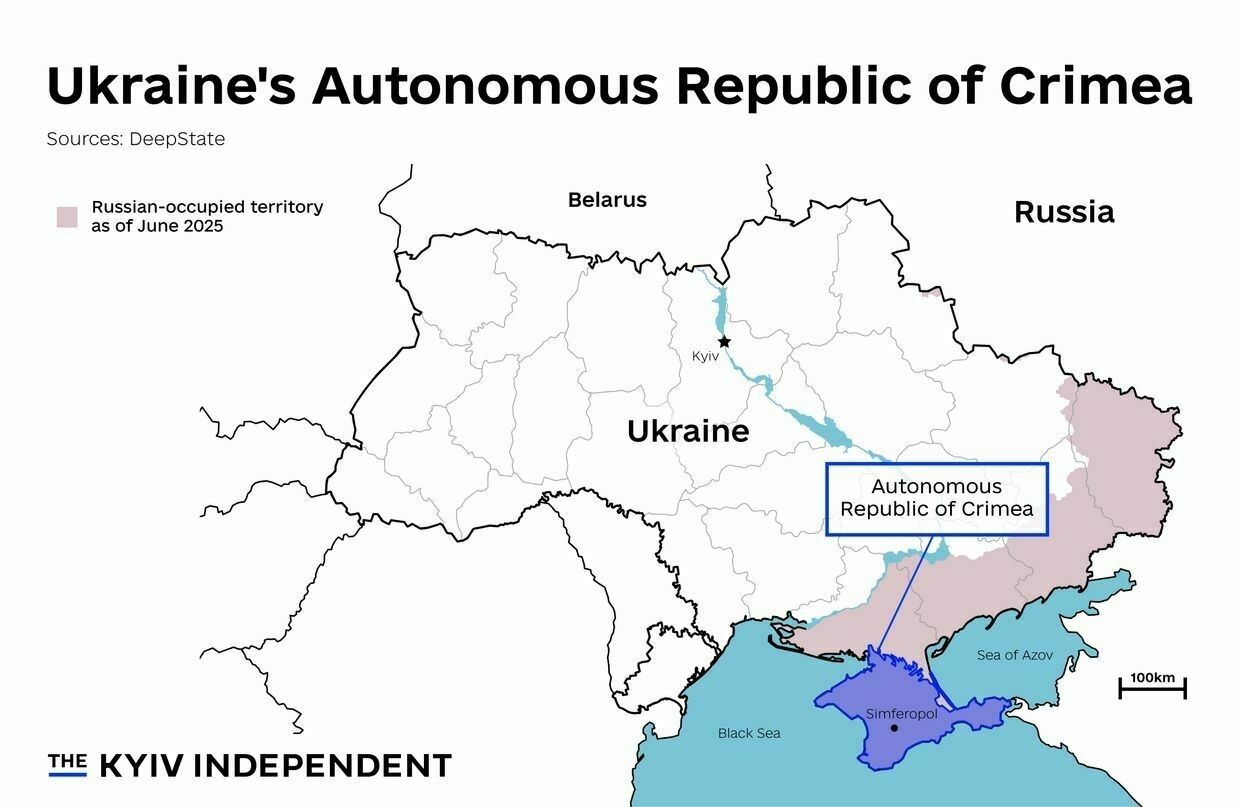
Ukraine’s Autonomous Republic of Crimea. (Nizar al-Rifai/The Kyiv Independent) Russia-Iran alliance wavers as Tehran suffers major blowsTehran, Russia’s main ally in the Middle East, has been dealt a heavy blow as Israel dismantled its network of proxies and then struck targets in Iran. The recent Iranian-Israeli war, which ended with a ceasefire on June 24, showed that the regional balance of power has shifted in Israel’s favor. This could have a major impact on Russian-Iranian relations as Moscow will have to recalibrate its approach to the region. Russian-Iranian cooperation is likely to continue but Iran’s ability to help The Kyiv IndependentOleg Sukhov
The Kyiv IndependentOleg Sukhov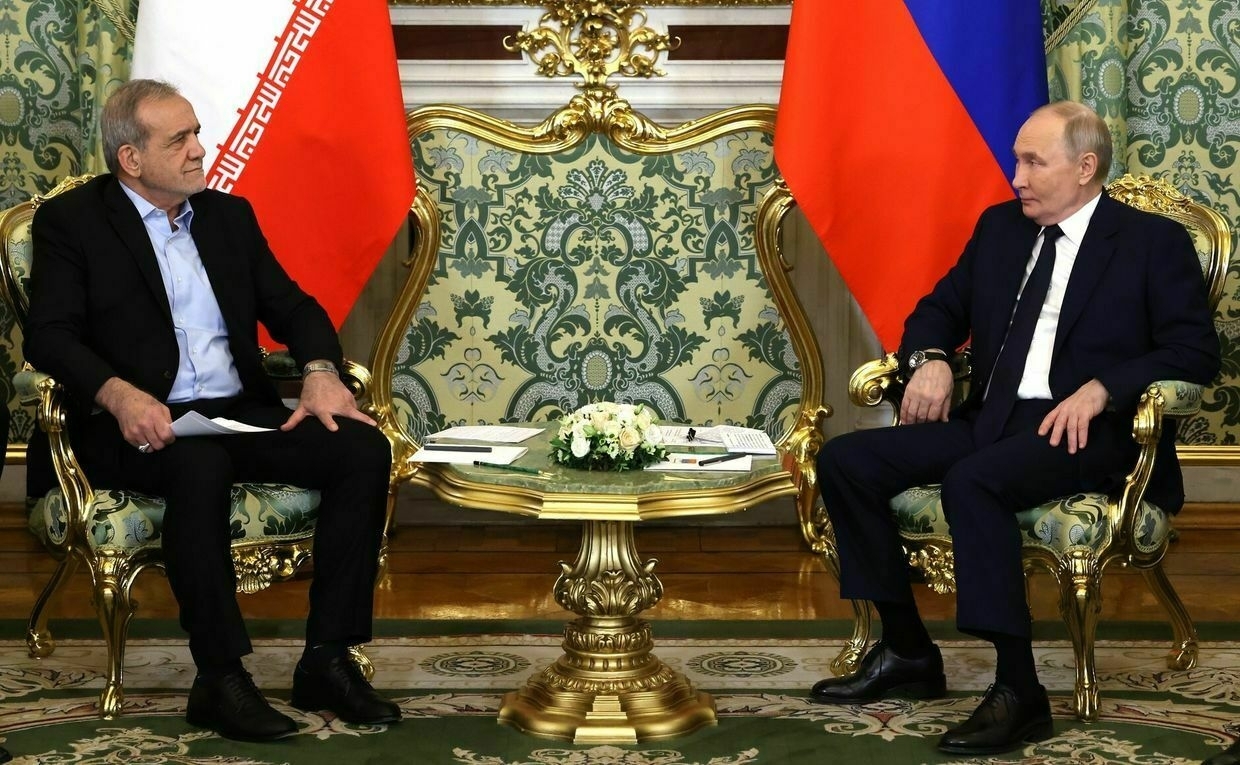
-
Ukraine's army chief bans tent camps for troops in training after Russian strikes
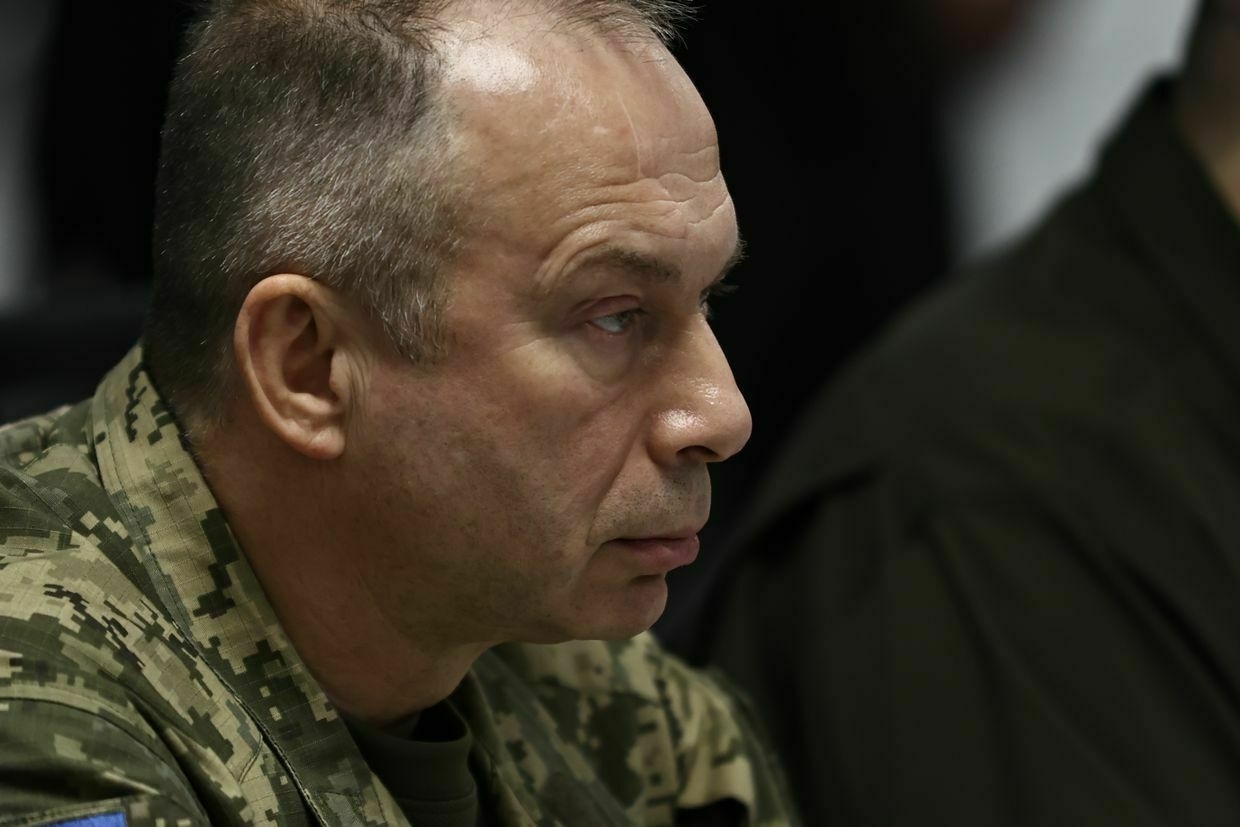
Commander-in-Chief Oleksandr Syrskyi said on July 1 that he had ordered a ban on the concentration of troops and equipment at training facilities to better protect against Russian missile attacks.
“My categorical order is to ensure and increase the safety of service members at training centers and training grounds,” Syrskyi said on social media after listening to reports on the implementation of safety measures.
“The concentration of personnel and military equipment, as well as the placement of service members in tent camps, is prohibited!"
The command follows a string of Russian missile attacks against Ukrainian military training facilities that have resulted in a number of killed and injured service members.
Deadly strikes deep inside the Ukrainian rear have sparked a public backlash and increased scrutiny aimed at the military command.
Former Ground Forces Commander Mykhailo Drapatyi promised to address the issue, but resigned after another attack against a shooting range in Sumy Oblast on May 20, which killed six soldiers and injured a dozen more.
Syrskyi said that new shelters and protective structures are being constructed at training facilities.
“I emphasized the mandatory compliance with shelter requirements at training centers and ranges, as well as the proper and timely notification of air raid alerts."
In a most recently reported case, a Russian missile attack killed three soldiers and injured 14 at the training ground of a Ukrainian mechanized brigade on June 22.
Ukrainian forces push Russian army away from Sumy, General Staff saysUkrainian troops advanced near the village of Oleksiivka and liberated the village of Andriivka, the statement read.The Kyiv IndependentKateryna Hodunova
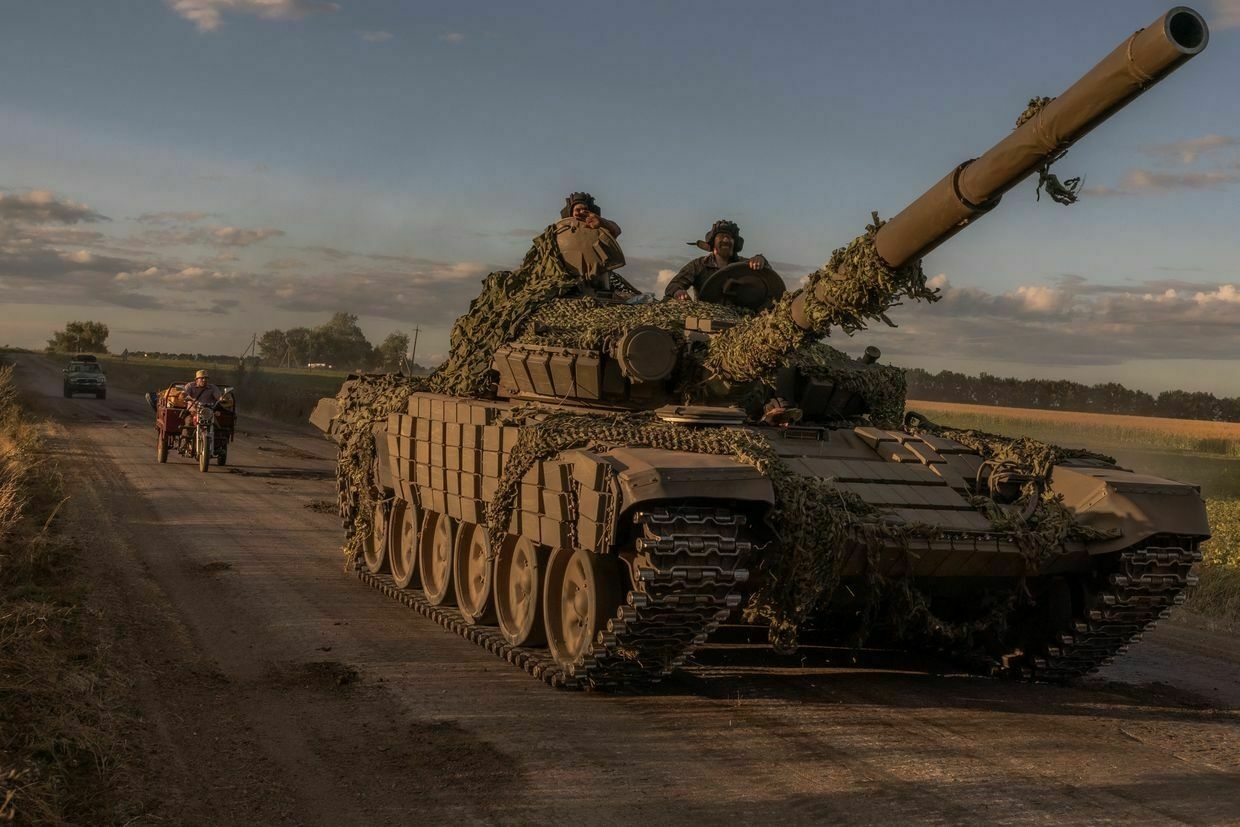
-
Kim Jong Un publicly honors North Korean soldiers killed in Russia-Ukraine war
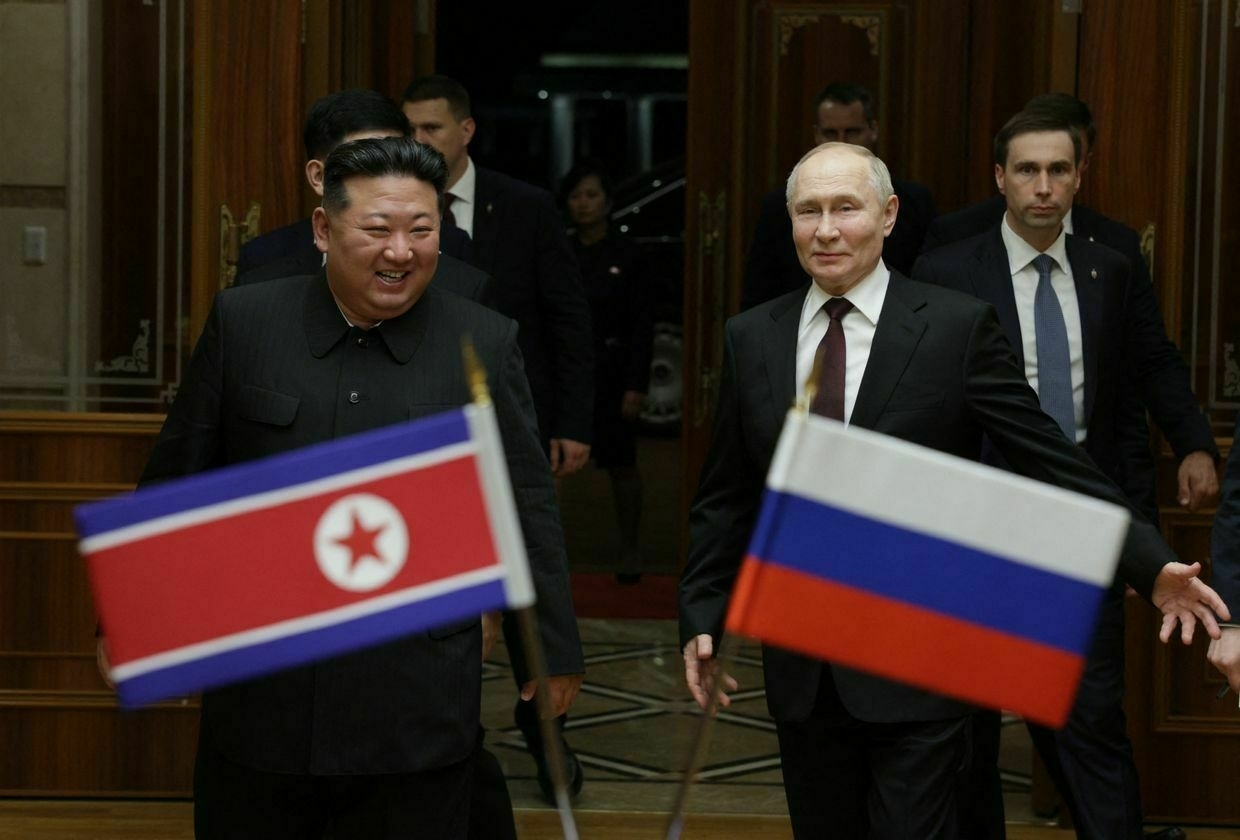
North Korean leader Kim Jong Un has publicly honored his country’s soldiers killed while fighting in Russia’s war against Ukraine, in a rare acknowledgment by Pyongyang of its battlefield losses, the Guardian reported on July 1.
South Korea estimates that North Korea has sent around 15,000 troops to support Russia, suffering approximately 4,700 casualties, including 600 deaths. More deployments are expected as early as July or August, South Korea’s National Intelligence Service (NIS) said.
Photographs of Kim resting his hands on flag-draped coffins were displayed during a gala concert in Pyongyang on June 30 to commemorate the first anniversary of a military treaty signed between North Korea and Russia.
Russian President Vladimir Putin and Kim signed the Comprehensive Strategic Partnership Agreement in Pyongyang in June 2024. Under the treaty, the two countries pledged to provide aid to one another if either is attacked.
The images of the concert showed at least six coffins and emotional scenes of Kim alongside top officials, including his sister Kim Yo Jong and Foreign Minister Choe Son Hui, all dressed in winter clothing, suggesting the repatriation may have taken place months ago.
The event at East Pyongyang Grand Theatre included performances by North Korean and visiting Russian artists and displayed images celebrating the alliance, including scenes of soldiers from both countries waving flags and purported pages from a blood-stained notebook said to belong to a North Korean soldier killed in Russia’s Kursk Oblast.
The Guardian reported that the ceremony was the first time North Korean state media had shown footage and photos of fallen troops in a way accessible to the North Korean public.
Footage broadcast on state-run KRT showed Kim appearing emotional at times while seated next to Russian Culture Minister Olga Lyubimova and his daughter, Kim Ju Ae. Audience members were seen wiping away tears.
Kim met with Lyubimova in Pyongyang on June 29 to discuss expanding bilateral cooperation in culture and the arts.
North Korea held a farewell ceremony for soldiers killed in Russia’s Kursk region. State TV aired footage of Kim Jong Un tearfully standing by a coffin — including hired state actors who were forced to cry. A concert in East Pyongyang also featured Russian songs. https://t.co/xV0TkminHs pic.twitter.com/WVWSSM5P1Y
— NOELREPORTS 🇪🇺 🇺🇦 (@NOELreports) July 1, 2025North Korea initially denied sending combat troops to Ukraine, but Kim's tribute follows official confirmations of Pyongyang's direct military involvement in the Russia-Ukraine war. In April, both Kim and Putin described North Korean troops deployed to Ukraine as "heroes."
Kim also announced plans to build a monument in Pyongyang to honor the fallen and lay flowers at their tombstones.
Pyongyang has reportedly begun recruiting additional soldiers for future deployments. The move would add to what Seoul describes as significant military support from North Korea, including more than 10 million artillery shells and multiple ballistic missile transfers in exchange for economic and technical assistance from Moscow.
North Korea may also send up to 25,000 laborers to Russia to support drone production, including Shahed-type loitering munitions at the Alabuga Special Economic Zone in Tatarstan.
Russian Security Council Secretary Sergei Shoigu visited North Korea on June 17 under a special directive from Putin and announced a deal for Pyongyang to send 1,000 sappers and 5,000 military engineers to Russia's Kursk Oblast.
Thousands of North Korean troops reportedly participated in front-line operations there, helping Russia repel a Ukrainian cross-border offensive that began in August 2024. Ukrainian forces briefly held 1,300 square kilometers (500 square miles) in Kursk Oblast before losing most of the territory during a Russian counteroffensive in March 2025, reportedly supported by North Korean units.
U.K. defense intelligence places North Korean casualties from that operation at more than 6,000.
Russia turns sound into weaponWhen I was at school and learned about World War II, my grandmother told me what she remembered of her wartime childhood on the English coast. Growing up near a Royal Navy base, she survived countless nighttime air raids. Most of all, she remembered exactly how the Blitz sounded — theThe Kyiv IndependentElsa Court
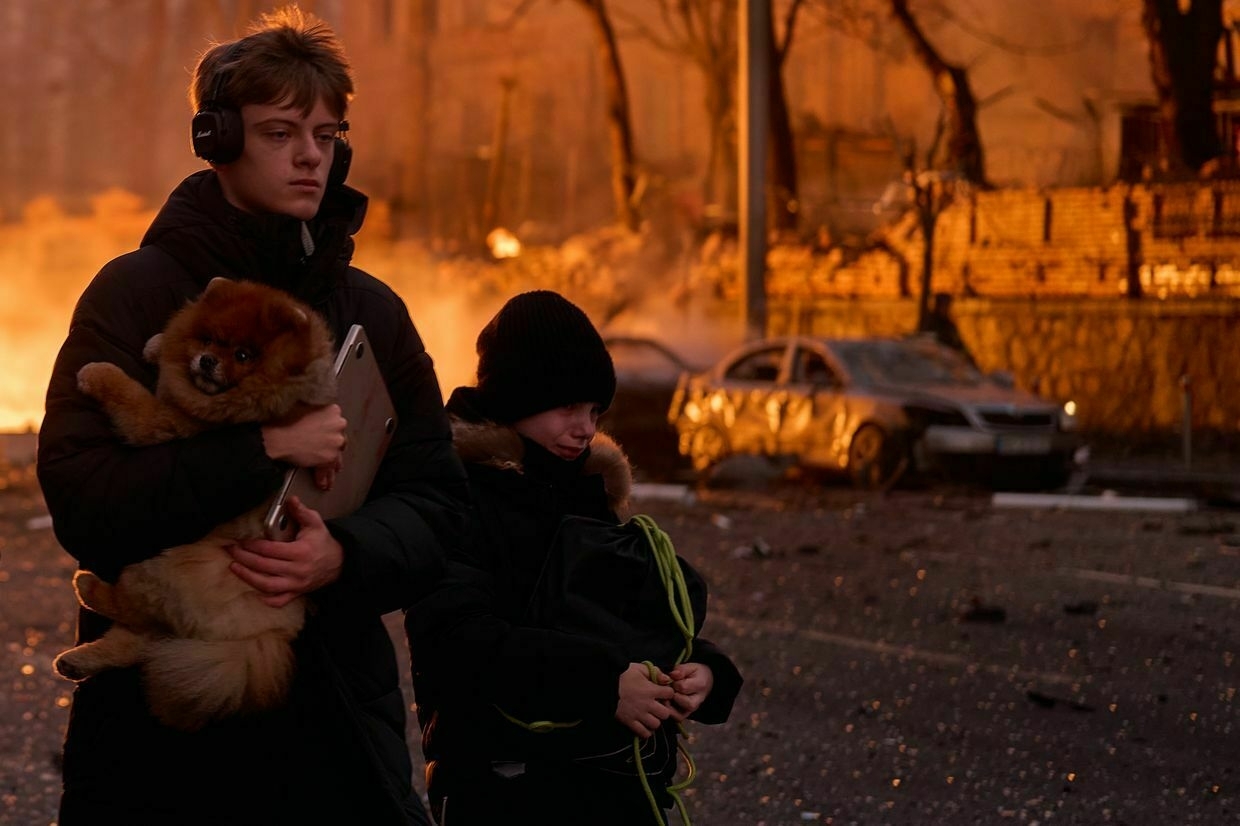
-
Russian missile attack targets Dnipropetrovsk Oblast, casualties reported
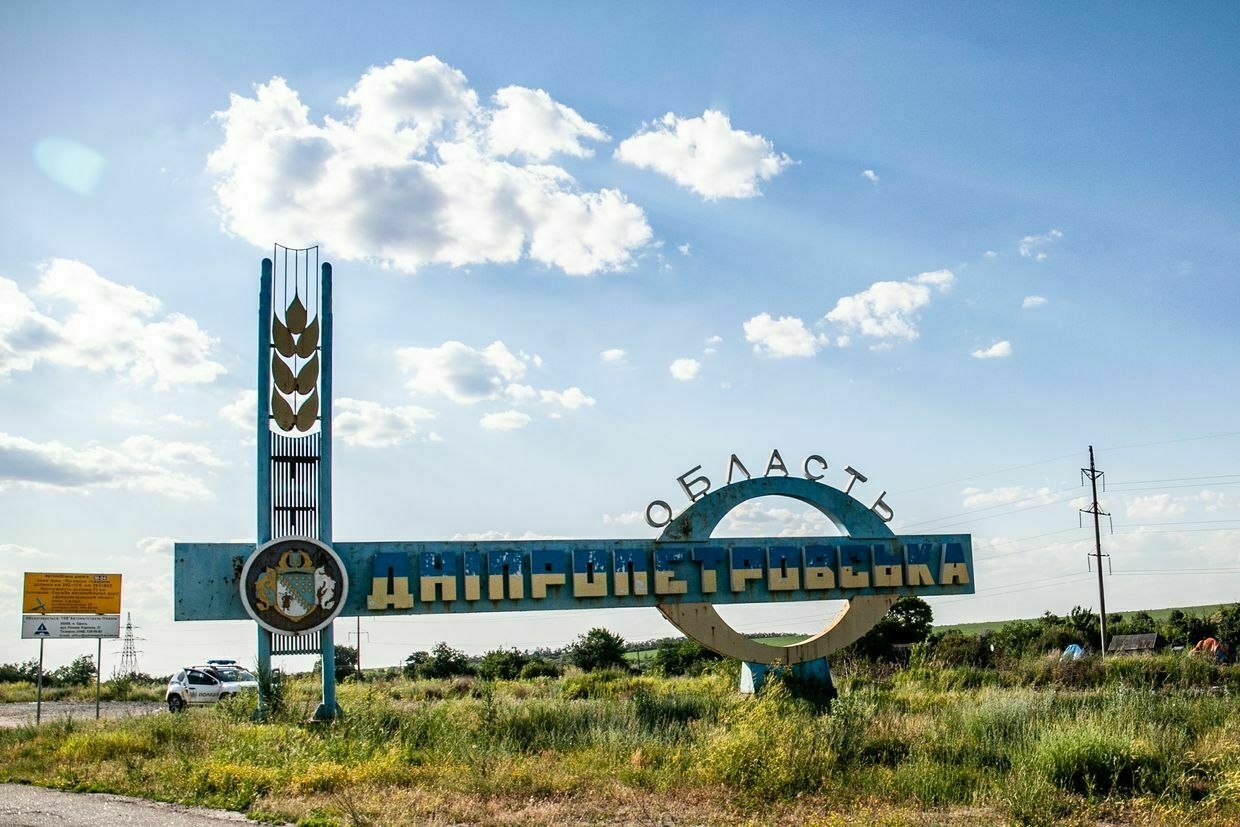
Editor’s note: This is a developing story and is being updated.
A Russian missile attack on the Kamianske district in Dnipropetrovsk Oblast on July 1 resulted in deaths and injuries, Governor Serhii Lysak reported.
The strike was reported at around 9:40 a.m. local time. At the moment, no further details about the consequences have been reported.
The Kamianske district lies in the western part of Dnipropetrovsk Oblast, an eastern Ukrainian region regularly targeted by Russian drones and missiles.
-
4 killed, 15 injured in Russian attacks on Ukraine over past day
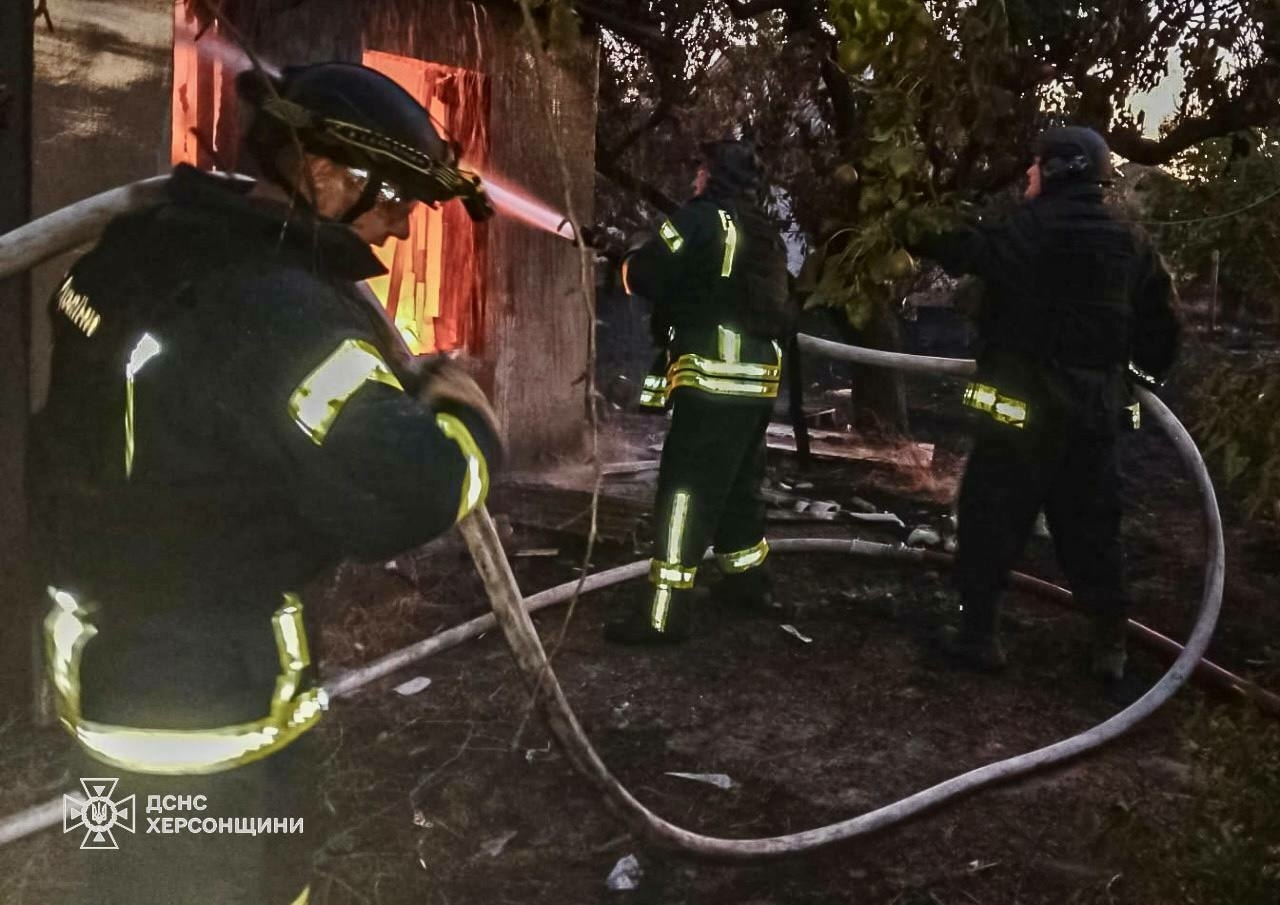
Russian strikes across Ukrainian regions killed at least four civilians and injured at least 15 over the past day, regional authorities reported on July 1.
Russia launched 47 Shahed-type attack drones and decoys against Ukraine overnight, the Air Force reported. Ukrainian air defenses shot down 14 drones, while 33 were intercepted by electronic warfare or disappeared from radars, according to the statement.
Russian attacks injured three civilians in Donetsk Oblast, Governor Vadym Filashkin reported.
In Kharkiv Oblast, two women aged 60 and 81 were injured during a Russian attack on the Tsykruny village, Governor Oleh Syniehubov reported.
Russian attacks across Kherson Oblast killed two people and injured five, said the regional governor, Oleksandr Prokudin. Three high-rise buildings and eight houses were damaged.
In Mykolaiv Oblast, a 45-year-old man was killed and a 37-year-old woman was injured during Russian shelling of the Kutsurub community on June 30, Governor Vitalii Kim reported. Houses, two schools, and a shop were damaged, and a fire erupted because of the attack.
A 75-year-old man was killed and his 76-year-old wife was injured during another artillery attack against the community on the morning of July 1, Kim said.
Two civilians were injured in Russian attacks against Sumy Oblast, the regional military administration reported.
In Zaporizhzhia Oblast, a 56-year-old man was wounded when Russia attacked the Polohy district, according to Governor Ivan Fedorov.
China unveils its new ‘graphite bomb’ — here’s how they workChina’s state TV broadcaster has revealed details of a new “graphite bomb” that can cause a “complete loss of electricity” across an area of 10,000 square meters, or knock out entire power stations, the South China Morning Post reported on June 29. An animated video released by China’s CCTV showed a missile being launched from a ground-based launcher and then flying to a target where it releases 90 small submunitions. They then bounce on the ground before exploding amid a mock-up of an electri The Kyiv IndependentChris York
The Kyiv IndependentChris York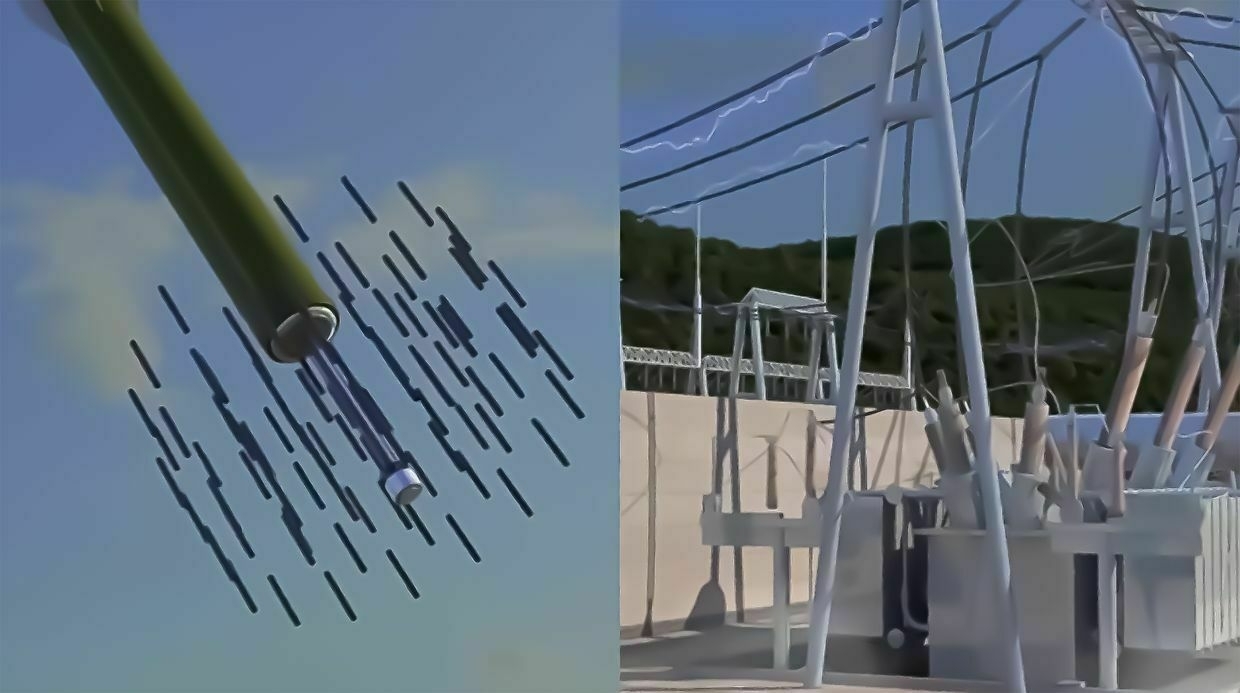
-
Ukrainian drones allegedly target Russian city 1,300 km from border
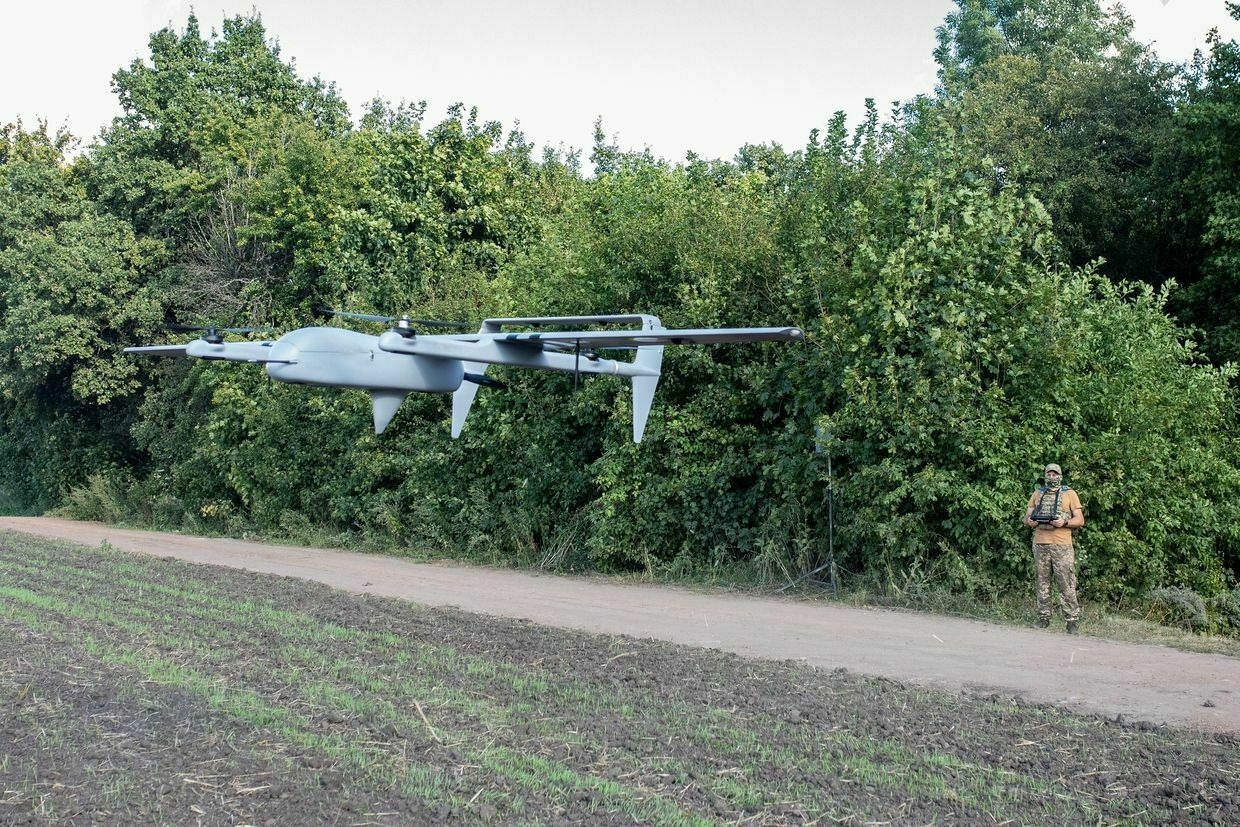
Ukrainian drones struck multiple targets across Russia and occupied Crimea overnight, including the Russian city of Izhevsk lying over 1,300 kilometers (800 miles) from the Ukrainian border, according to Russian officials and local Telegram channels.
Residents of Izhevsk reported explosions early on July 1, while local authorities confirmed a drone strike on a facility in the city. Alexander Brechalov, head of Russia’s Udmurt Republic, said emergency services had responded to the attack and that further information would be provided as it became available.
Russia’s aviation agency temporarily suspended flights in and out of the city’s airport following the incident.
The city was previously targeted on Nov. 17, 2024, when a drone strike damaged a factory known for producing air defense systems, including Tor missile systems and radar components used by the Russian military. That strike marked the first known Ukrainian drone attack on the region during the full-scale war.
Russia’s Defense Ministry said its air defenses shot down 60 Ukrainian drones overnight across several regions, including 17 over occupied Crimea, 16 over the Rostov Oblast, and 11 over the Sea of Azov. Others were reportedly downed over the Kursk, Saratov, Belgorod, Voronezh, and Oryol oblasts, as well as the Black Sea.
In occupied Crimea, local Telegram channels reported explosions near the town of Kurortne on the Kerch Peninsula, where Russian S-300/S-400 surface-to-air missile systems and radar stations are allegedly located. A monitoring group cited NASA satellite data showing a large fire in the area overnight, though there was no official confirmation of any damage to the air defense assets.
Local residents reported explosions between 0:20 a.m. and 0:50 a.m. in the cities of Kerch and Feodosia.
Ukraine has not officially claimed responsibility for the attacks, and its military intelligence agency has not commented. The Kyiv Independent could not independently verify the information.
Smashing previous monthly record, Russia launches 5,337 kamikaze drones against Ukraine during JuneRussia launched a record 5,337 Shahed-type drones against Ukraine in June, according to data from the Ukrainian Air Force and Dragon Capital, smashing the previous record of 4,198 set in March. Russia’s bombardments, a fact of life after three years of full-scale war, have intensified dramatically in MayThe Kyiv IndependentYuliia Taradiuk
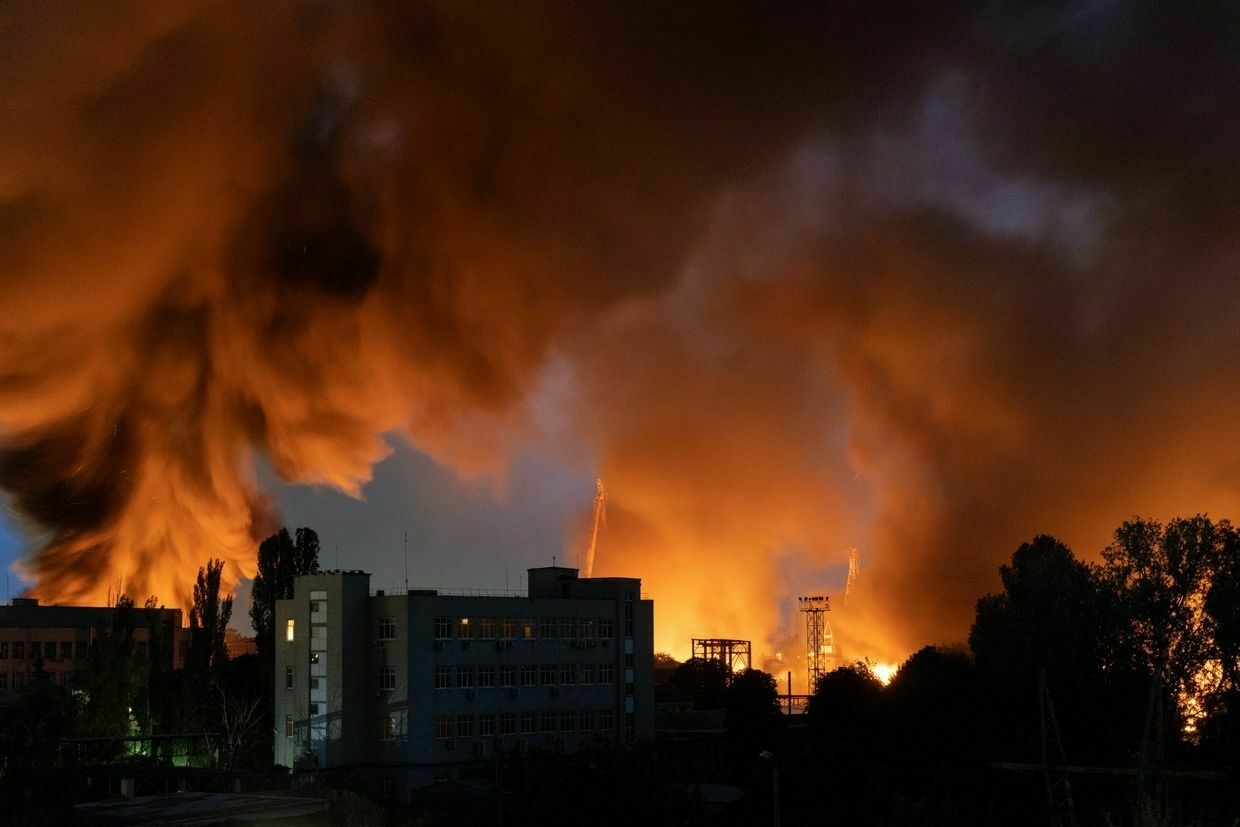
-
Ukraine developing new anti-drone ammunition to counter Russian aerial attacks
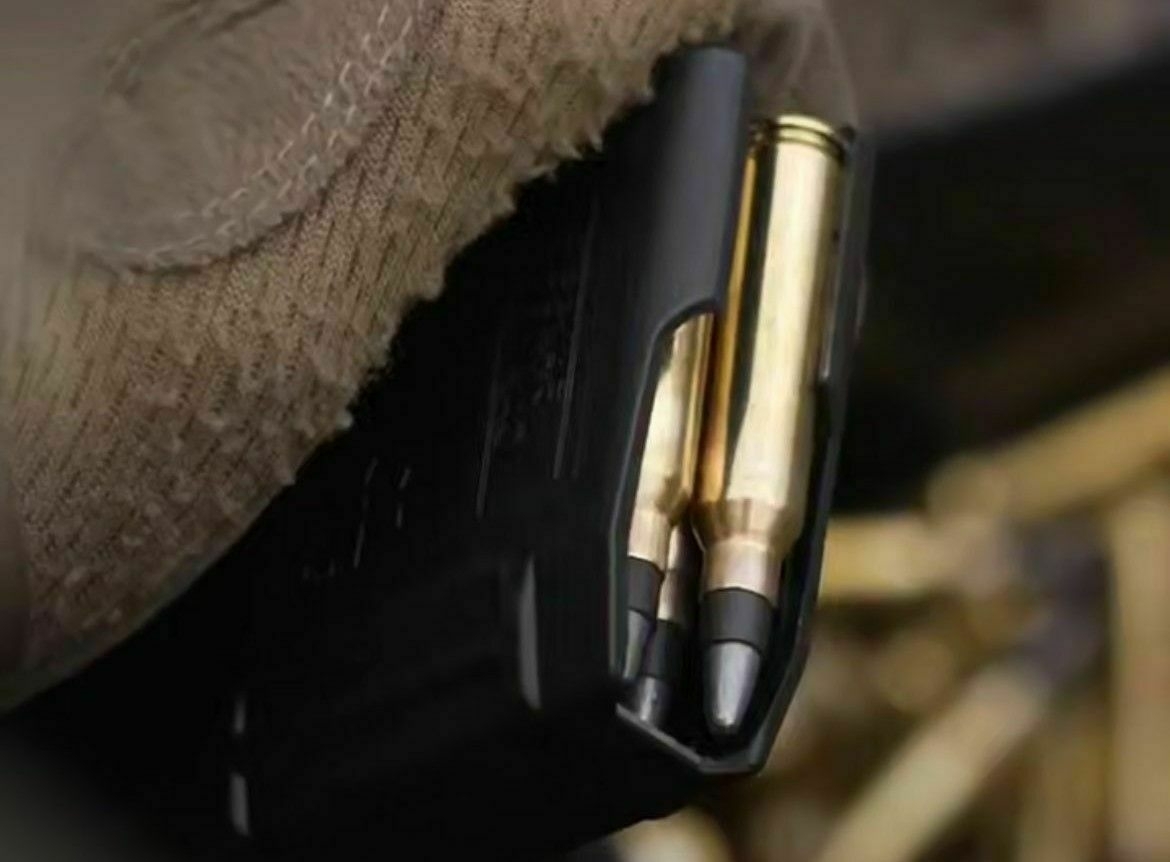
Ukraine’s defense technology cluster Brave1 has launched the development of anti-drone rifle rounds, significantly increasing the chances of hitting fast-moving aerial targets, the group said in a statement on June 30.
According to Brave1, the ammunition appears similar to standard rounds used in automatic rifles but features a specially designed warhead that increases the likelihood of shooting down FPV (first-person-view) drones or commercial quadcopters such as the DJI Mavic before they strike.
These types of drones are being used extensively on the battlefield by both Ukrainian and Russian forces. The cost-effective FPV drones have proven highly effective in destroying expensive military equipment.
The manufacturer has already codified the new rounds according to NATO standards, Brave1 said. The goal is to supply every infantry soldier with a magazine of specialized ammunition for use in case of aerial threats.
“These rounds that significantly improve the chances of hitting a moving target are a new development by Brave1,” Digital Transformation Minister Mykhailo Fedorov said.
“Our common goal is to ensure that every infantryman has a magazine of such ammunition and can equip his rifle with it in case of an air threat."
Ukraine continues to scale up its drone warfare capabilities. The Defense Ministry said on March 10 that it plans to purchase 4.5 million FPV drones in 2025 at a cost exceeding Hr 110 billion ($2.6 billion), with most of the funds allocated through the Defense Procurement Agency.
President Volodymyr Zelensky has set a goal of producing at least 30,000 long-range drones in 2025.
Tired of military aid delays, Ukraine has designed its own ballistic missile — and it’s already in mass-productionUkraine announced on June 13 that its short-range Sapsan ballistic missile would go into mass production, a major development in Kyiv’s ongoing efforts to domestically produce the weapons it needs to fight Russia’s full-scale invasion. As Ukraine faces growing challenges in securing weapons from Western partners, and Russia continues launchingThe Kyiv IndependentYuliia Taradiuk
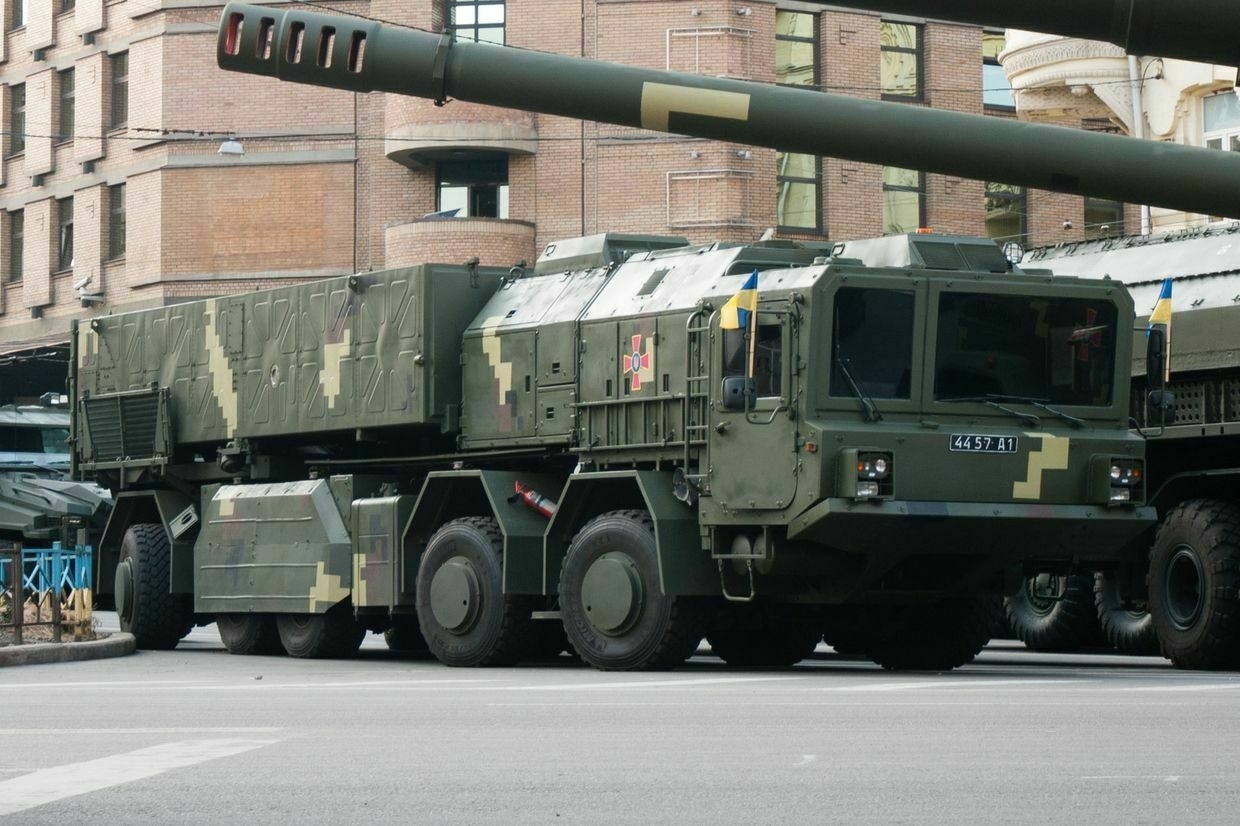
-
Iran summons Ukraine's envoy, warns of 'consequences' over comments on Israeli, US strikes
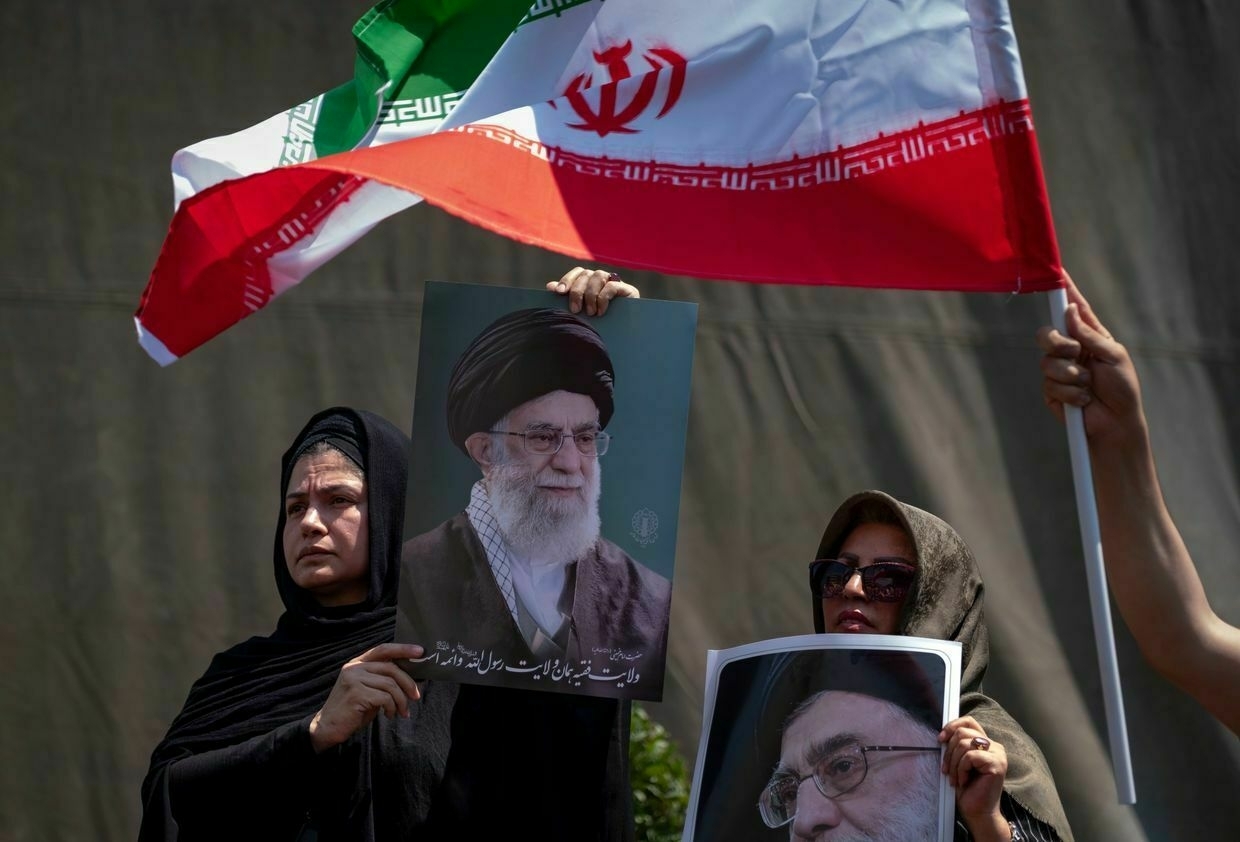
The Iranian Foreign Ministry has summoned the Ukrainian charge d’affaires to protest “inappropriate remarks” by Kyiv regarding recent Israeli and U.S. strikes on Iran, the ministry said on July 1.
Tehran threatened Ukraine with unspecified “consequences” should such statements be repeated.
The diplomatic spat follows a wave of Israeli and U.S. air strikes targeting Iran’s nuclear program, with Iranian forces attacking Israel and a U.S. base in Qatar in response.
Highlighting Iran’s military support for Russian aggression against Ukraine, Kyiv responded by calling for the dismantling of the Iranian nuclear program to prevent it from threatening the Middle East or the wider world.
In response, Shahram Farsaei, head of the Iranian Foreign Ministry’s Eurasian affairs department, relayed a protest note to Ukraine via the Ukrainian envoy in Iran, Kyrylo Pozdniakov. The ministry did not specify what exact comments prompted the reaction from the Iranian side.
Tehran also said that Ukrainian officials have “disregarded Ukraine’s international legal obligations concerning respect for the principles and purposes of the U.N. Charter as well as the four Geneva Conventions."
Iran has provided ballistic missiles and thousands of Shahed drones to Russia, directly backing its armed aggression in Ukraine, itself launched in violation of international law and the U.N. Charter.
Moscow has backed Iran diplomatically after U.S. and Israeli attacks, urging a response from the U.N. Security Council and calling the attacks an “unprovoked aggression."
Russia-Iran alliance wavers as Tehran suffers major blowsTehran, Russia’s main ally in the Middle East, has been dealt a heavy blow as Israel dismantled its network of proxies and then struck targets in Iran. The recent Iranian-Israeli war, which ended with a ceasefire on June 24, showed that the regional balance of power has shifted in Israel’s favor. This could have a major impact on Russian-Iranian relations as Moscow will have to recalibrate its approach to the region. Russian-Iranian cooperation is likely to continue but Iran’s ability to help The Kyiv IndependentOleg Sukhov
The Kyiv IndependentOleg Sukhov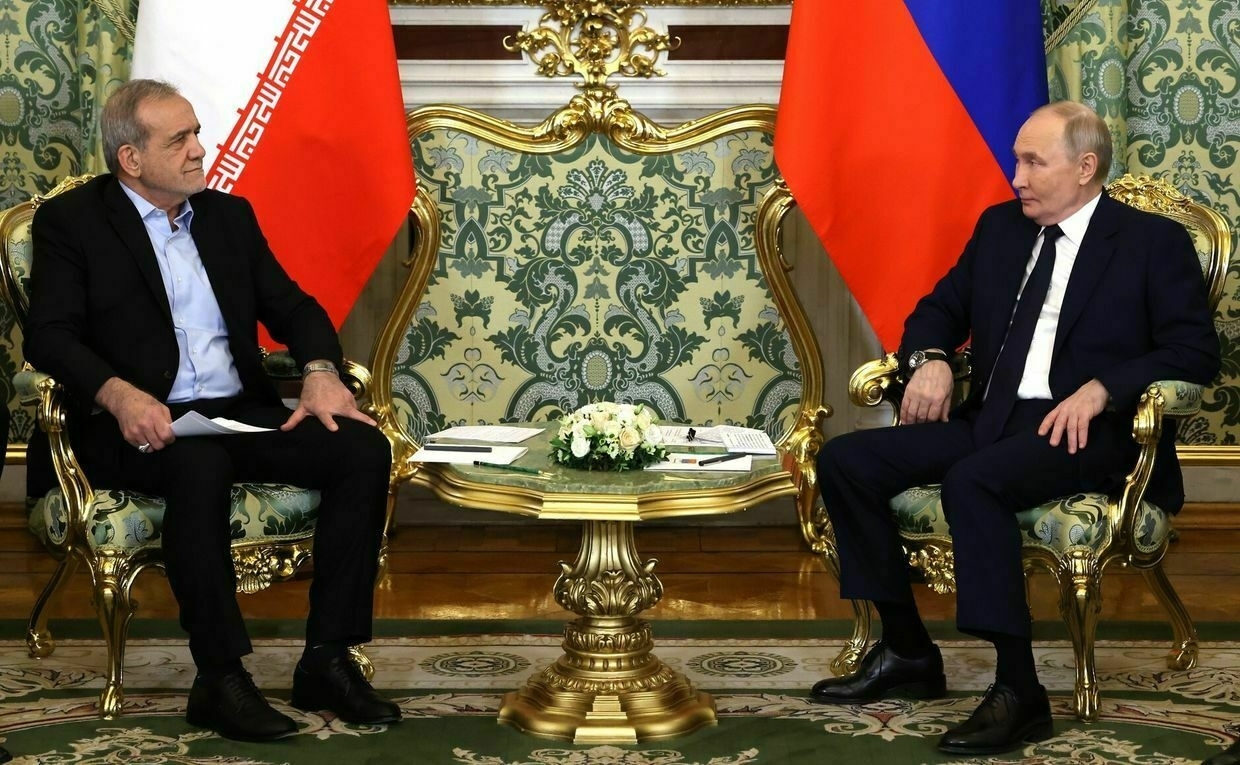
-
Crisis Response Networks: Wartime Civic Engagement in Ukraine’s Local Governments
In times of war, governance tends to become more centralized, top-down, and security-driven (Hart, Rosenthal and Kouzmin 1993, Kyvelou and Marava 2017). Democratic participation is often suspended in favor of executive control (Lasswell, 1941; Desch, 1996; Lowande & Rogowski, 2021).
Yet in Ukraine, despite the ongoing full-scale Russian invasion and the constraints of martial law (Rabinovych et al., 2025), many local governments (hromadas) have continued to involve civil society in crisis response (Keudel & Huss, 2024). Rather than being sidelined, civic actors in many communities have remained engaged in local decision-making, resource coordination, and public service delivery.
This article examines how Ukrainian hromadas have sustained civic engagement in local crisis governance during wartime. Leveraging survey and case findings, we show a clear pattern: collaborative participation can enhance preparedness and help maintain democratic legitimacy even under martial law.
Drawing on survey and interview data from over 180 municipalities, we argue that Ukraine offers an instructive case of collaborative crisis governance – a mode of network-based governance in which local authorities engage other stakeholders to gain resources, knowledge, and coordination capacity to collective problem-solving.
This article draws on the findings of ICLD Research Report No. 33, Local Democracy and Resilience in Ukraine: Learning from Communities’ Crisis Response in War, authored by Oleksandra Keudel, Oksana Huss, Valentyn Hatsko, Andrii Darkovich. We gratefully acknowledge the generous financial and institutional support of the Swedish International Centre for Local Democracy (ICLD), whose funding made this project possible and enabled our collaborative research on wartime local democracy and community resilience in Ukraine.
The full survey dataset used in this research has been published on DiscussData and is ferry available for download
Ukraine’s Decentralization Reform Before and After the Full-Scale Invasion
Since 2014, Ukraine’s decentralization reform has fundamentally transformed local governance. The reform transferred key responsibilities—budgeting, public services, and local development—to newly amalgamated municipalities (hromadas), giving them greater autonomy and financial capacity. This shift fostered a more responsive and participatory model of governance and created institutional conditions for collaborative practices between local authorities, civil society, and businesses.
However, the introduction of martial law due to Russia’s full-scale invasion has led to changes in the areas of responsibility of local self-government (LSG). Emergency coordination, defence logistics, and civil protection were partly recentralized, and regional state administrations were converted into military administrations with expanded authority. Military personal income tax, a growing share of local budgets in affected areas, was reallocated to the national level. In frontline areas, 13% of hromadas now operate under military administrations, heads of which are appointed by the president.
Despite these constraints, the suspension of elections, and many challenges in public informing and engagement (Figure 1), local governments have remained key actors in wartime governance. They continue to maintain public services, coordinate humanitarian aid, and support displaced populations.
Figure 1. Challenges of public informing and engagement initiatives at times of war
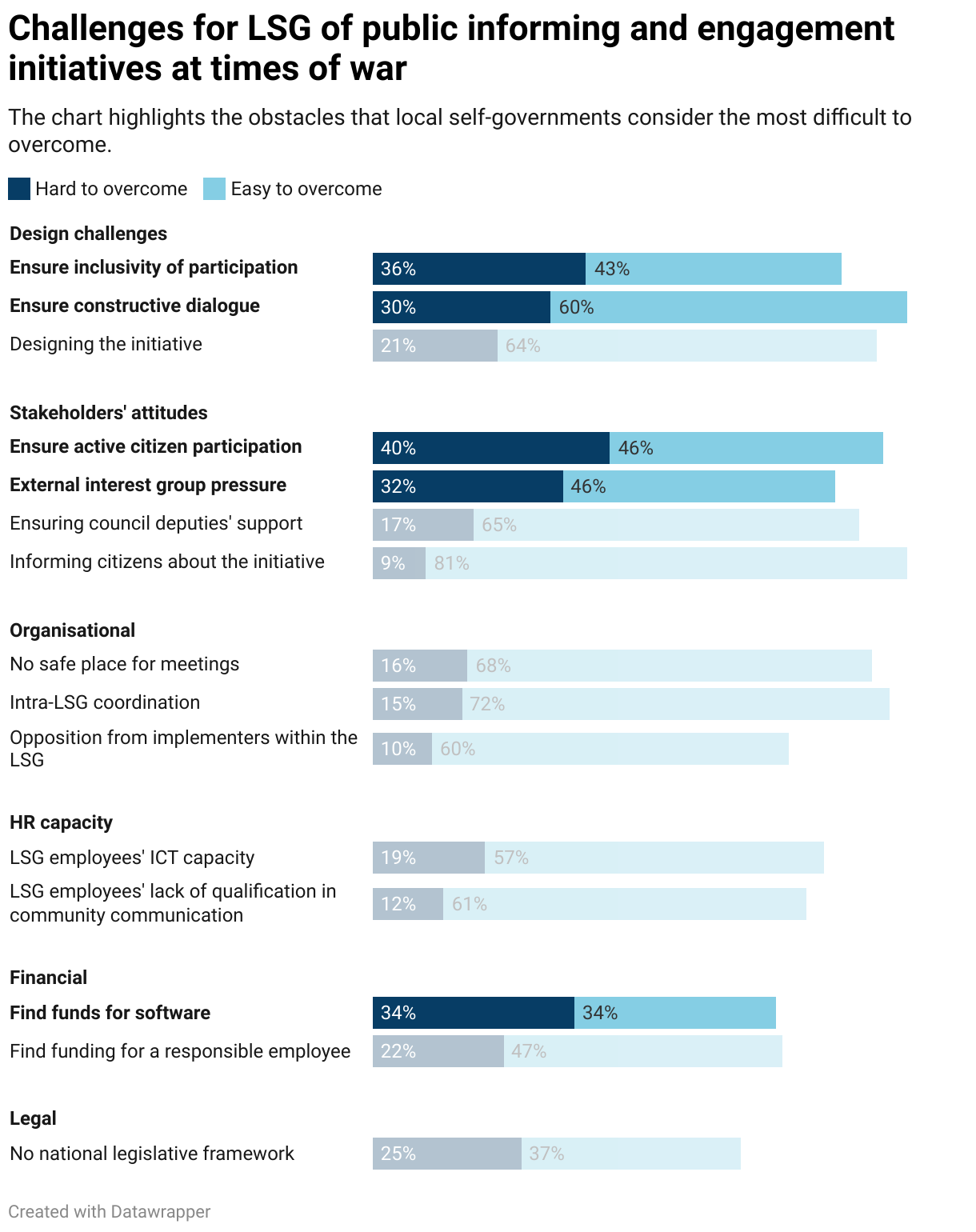
Source: Authors’ own survey
Note: N = 129 (LSG with any initiatives to inform and/or engage citizens or businesses in the past 12 months). Question: In the initiative mentioned above, to inform or engage citizens that you have implemented, what challenges did you have to overcome during the implementation process? Options: hard to overcome; easy to overcome; the challenge was not overcome; not relevant.The figure shows “hard to overcome” and “easy to overcome” responses. Challenges that were ‘hard to overcome’ for 30% and more respondents are highlighted.
Methods
This analysis draws on original survey data[4] from 181 local governments collected between January and March 2024, complemented by interviews, focus groups, and a validation workshop with public officials and civil society actors. The survey was conducted as an online questionnaire, distributed via nation-wide local government associations and NGOs. We received one response per municipality; if more than one official replied, we used the response from the highest-ranking respondent. Respondents were mainly mayors and deputy mayors, with heads of local government units as the next largest group. About 14% of Ukrainian municipalities in government-controlled areas participated in the survey.
To analyze changes over time, we compare results with three earlier studies conducted in 2021[5], 2022[6], and 2023[7]. These previous studies included questions on preparedness, vertical coordination, public engagement, and digital communication, many of which were repeated, sometimes in a slightly different form, in 2024.
Figure 2. LSGs surveyed by region
Source: Authors’ own survey. Note: This study faces a sampling constraint: Zaporizhzhia oblast is over-represented because we could not survey de-occupied or frontline hromadas in Kherson, Luhansk, and Donetsk. To reach those areas, we partnered with the NGO People in Need, whose activities were then concentrated in Zaporizhzhia. This NGO helped us distribute survey to the leaders of de-occupied hromadas and those near frontlines. The collaboration helped us manage survey fatigue and counter the low priority that frontline hromadas understandably give to research amid daily challenges
Collaborative Crisis Response: Community Members as Partners
Legitimacy Pursuit Through Public Engagement
Rather than retreat from the public, many Ukrainian local governments have actively involved community members in wartime crisis response. These efforts go beyond basic service provision and reflect a broader strategy of coproduction where authorities and societal actors jointly shape crisis responses. Under martial law, when elections are suspended, this engagement serves as an alternative source of democratic legitimacy.
Survey data from 2024 show that 71% of LSGs reported informing and/or engaging residents or businesses in the past year. This share remained stable even in areas experiencing active hostilities (69%) or those that were liberated (64%). At the same time, more local governments reported involving stakeholders directly in problem-solving (76%, 2.2 percentage points more than in 2022) and including diverse opinions (78%, 13 percentage points more than in 2022) (Figure 3). These trends suggest that deliberate civic participation is increasingly used as a tool for democratic resilience, functioning as an alternative pillar of legitimacy and accountability in the absence of elections.
Figure 3. The purpose of wartime public information and engagement initiatives by LSGs in 2024 compared to 2022
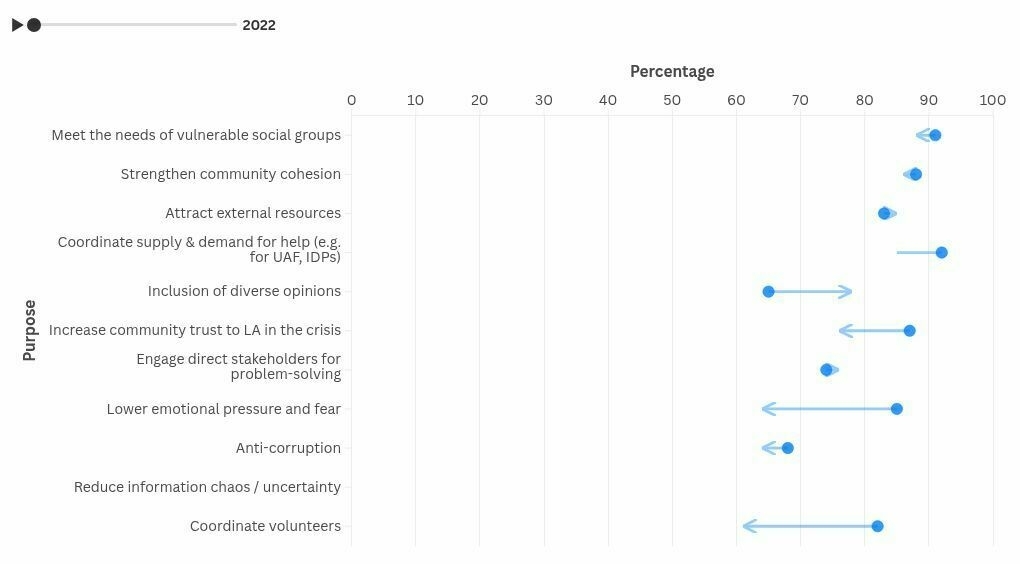
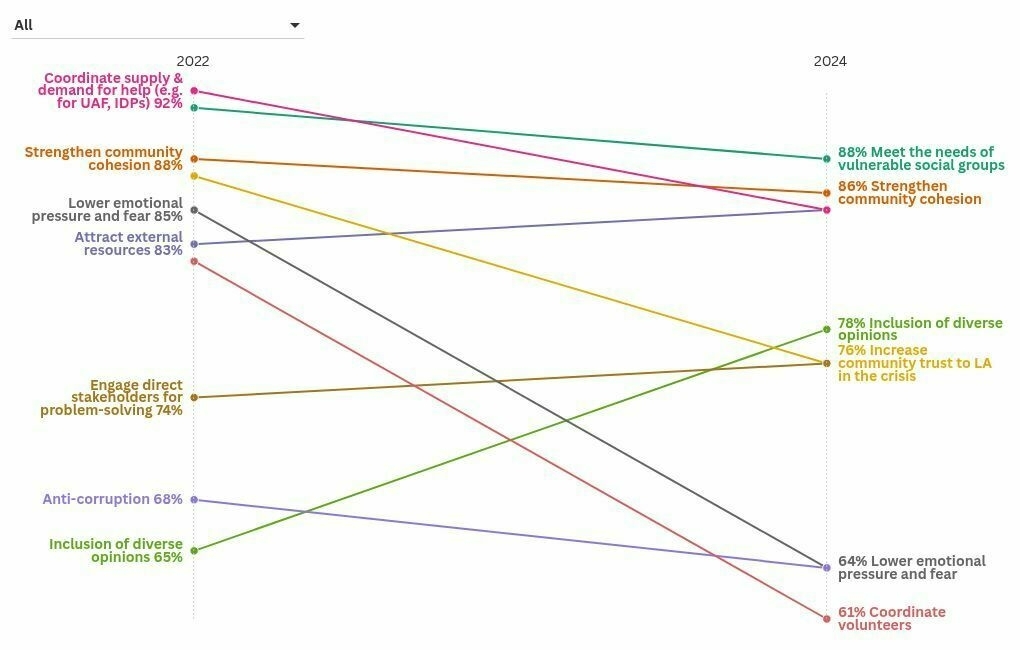
Source: Authors’ own survey. Note: N 2024 = 129, N 2022 = 160 (for LSGs that have initiatives to inform and/or engage citizens or businesses); the question was: “For what purpose did the LSG in your community introduce initiatives to inform and/or engage citizens or businesses in the last 12 months?” Respondents indicated primary and secondary purposes, as well as those that were irrelevant. The figures show only primary purposes.
One striking example comes from Makariv in Kyiv Oblast, a village that was massively damaged in the early days of the full-scale war. Rather than centralize postwar planning, the local government involved the whole community—including political opposition figures—in urban development workshops. Over time, these deliberations led to the formation of a “community development council“. This is an informal group which includes opposition parties and local government council members. At the council meetings they, with the assistance of NGOs, discuss projects in hromada such as creation of a Veterans’ hub.
Another form of collaboration emerged around the integration of internally displaced persons (IDPs). Over 750 local and regional governments have established IDP councils—advisory bodies that include both officials and displaced residents or their representatives. They serve as a communication channel between local authorities and displaced residents, helping to identify needs, share available support options, and coordinate responses. They represent a form of protected consultation—a meaningful participatory practice within the limits imposed by war.
Coproduction of Solutions to War-Related Problems
Local governments have increasingly adopted coproduction during the war—not just consulting civic actors but collaborating with them in designing and implementing responses.
This engagement was primarily motivated by practical needs: to build up community resources (85%), meet the needs of vulnerable social groups (88%), and coordinate the supply and demand for aid, including assistance for internally displaced persons (IDPs) and the Ukrainian military (85%) (Figure 3). Compared to 2022, there was a marked increase in efforts to include diverse opinions (+13 percentage points), while activities related to mitigating emotional pressure and fear (–21 pp) and coordinating volunteers (–20 pp) declined. This shift reflects a move toward more structured and targeted forms of collaboration focused on delivering immediate assistance.
The most common area for engagement was the integration of internally displaced persons (IDPs), with 34% of LSGs identifying it as the most critical issue addressed jointly with stakeholders. Other areas included civilian defense and security (21%) and provision of basic necessities (17%). In nearly all cases, LSGs informed at least one stakeholder group when addressing a critical issue. At the same time, only about a fifth of all respondents reported no engagement across the other three dimensions of participation—consultation, dialogue, and partnership—suggesting that collaboration is a widespread mode of crisis response.
The findings expose a latent governance informing deficit: roughly one-quarter of hromadas (25%) did not inform citizens about the latest critical issue in hromada. Addressing this communication shortfall could catalyze higher levels of institutional trust and unlock additional local resources essential for tackling critical problems within these communities.
Figure 4. Extent of stakeholder engagement in response to critical war-related local problems
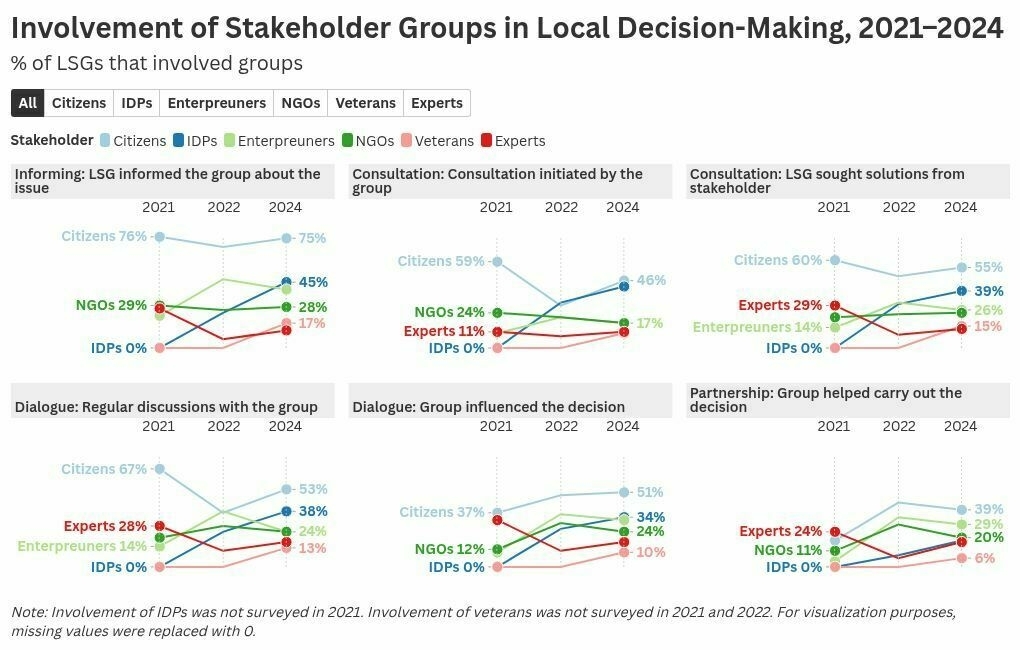
Source: Authors’ own survey. Note: N = 127 (LSGs outside of combat areas, LSGs in combat areas, and liberated LSGs that engaged the public and/or business on critical issues over the last 12 months); the question was: “Regarding the problem you identified in the previous question, which stakeholders were involved, and how did they participate in solving the problem?”
Particularly since 2022, collaboration with IDPs has expanded (Figure 4). LSGs have proactively shared information and regularly consulted IDP groups, often with support from NGOs acting as facilitators. These intermediaries help communicate needs and guide local authorities in adjusting programs. Although responsiveness to stakeholder input varies, the increased reliance on this form of engagement reflects a growing appreciation for grassroots knowledge in problem-solving.
NGOs and businesses also play crucial roles in collaborative crisis governance. NGOs have helped create inclusive infrastructure, such as community centers and bomb shelters. A notable example of institutional cooperation between local government and business is the UNBROKEN rehabilitation initiative in Lviv. It is jointly managed by the Lviv IT Cluster, the Ukrainian Catholic University, and the city government. Together, they coordinate activities and fundraising, ensuring transparency and shared responsibility.
Finally, 10–15 percent of LSGs indicate that they inform or consult former soldiers about issues beyond veteran policy. For example, Makariv specifically contacted the local veteran society during reconstruction discussions. This reflects how LSGs are sensitive to the composition of their communities and understand the significance of veteran inclusion for social cohesion.
Public Engagement Supports Crisis Preparedness
We tracked hromada preparedness at three moments of the full-scale war—February 2022, October 2022 and March 2024—using a 0-to-1 index (where 0 = absolutely not prepared and 1 = fully prepared; see Appendix for details). In the first days of Russia’s full-scale invasion, almost 80% of local self-governments fell into the “low” red zone (score < 0.25; Figure 5), i.e. they were completely unprepared to deal with the invasion. Eight months later, this group had nearly disappeared, replaced by a surge in hromadas with moderate (0.25-0.75) and high (> 0.75) readiness. By March 2024, roughly 70% of hromadas clustered in the moderate band, while the share of the highly prepared group declined to about one-third, signalling a plateau.
Figure 5 illustrates this dynamic: the red curve collapses (low preparedness), the orange curve (moderate) rises steadily, and the green curve (high) forms a “hill”—a sharp climb through 2022 followed by partial retreat in 2024. In simple terms, communities rapidly closed the most critical gaps, but are now settling into a sustainable, although still incomplete, level of readiness.
Figure 5. Distribution of hromadas by Preparedness Index. Comparison February 2022, October 2022, and March 2024
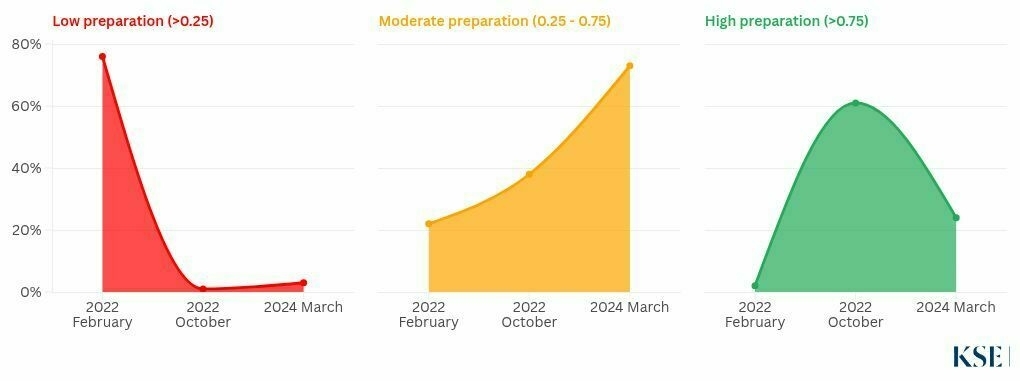
Source: authors’ calculations
Note: In February and October 2022 data come from the survey within the framework of the Project “Support to the Decentralisation Reform in Ukraine” (U-LEAD with Europe): N = 131 (all LSGs except those that are temporarily occupied). March 2024 data come from ICLD survey: N = 156 (LSGs outside combat areas, on the territory of hostilities and liberated LSGs). Information on February 2022 was retrospectively asked in October 2022.
Disaggregating the data adds a nuance. Urban and densely populated hromadas are significantly better equipped than rural and smaller counterparts. This underscores how resource availability and institutional capacity influence crisis resilience.
Furthermore, our regression analysis shows that local governments engaging a broader range of stakeholders are better prepared to manage wartime crises (Figure 6). Our preparedness index measures key components of crisis capacity: emergency action planning, readiness to address critical resource shortages (e.g., food, water, medicine), and the ability to restore vital infrastructure. Even when controlling for contextual factors, higher levels of stakeholder involvement are associated with higher preparedness scores.
The likely mechanism behind this relationship is that non-governmental actors help local authorities mobilize resources and co-develop crisis response strategies. This makes engagement not just a democratic practice, but a functional tool of resilience governance.
Figure 6. Standardized regression estimates of nongovernmental stakeholder impact on crisis preparedness
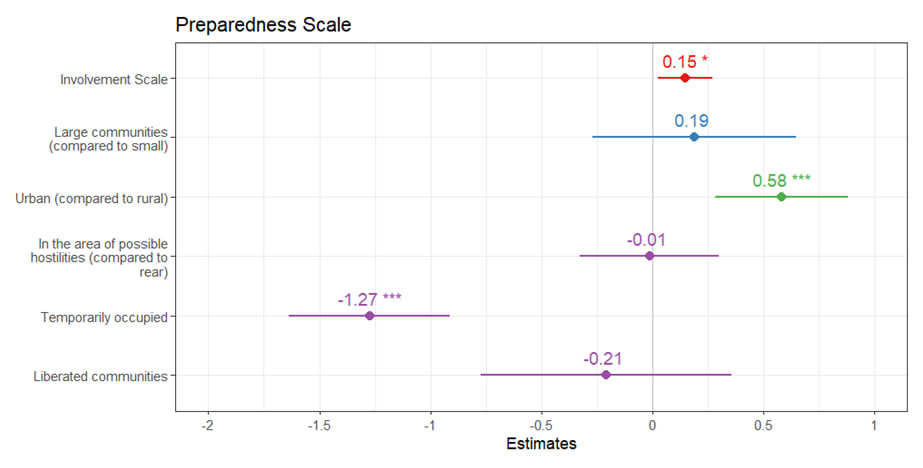
Source: Authors’ calculations. Note. The Involvement Index has a positive and statistically significant effect on preparedness (β = 0.149, p = 0.016). For example, a 10-point increase in involvement (on a 0–35 scale) is associated with a 0.22-point rise in preparedness (on a 0–1 scale), implying that highly engaged hromadas are over 20 percent more prepared than those with minimal stakeholder engagement. The model explains 35.6 percent of the variance (R² = 0.356, n = 181). Control variables include hromada size, hromada type, and security conditions.
Yet, not all local governments make full use of this approach. Only about one-third of those surveyed said they involve NGOs and businesses in planning their crisis response. Since this kind of collaboration helps improve preparedness, it remains a missed opportunity for many hromadas. Increasing civic engagement—especially with support from international donors and national programs—can help strengthen local crisis response in the long term.
Our findings also point to a second important factor: the availability of community spaces. Our data show a positive correlation between the number of physical or discursive spaces in a hromada and the extent of stakeholder involvement (Figure 7). In short, the more accessible public spaces in hromada are, the more likely it is to involve diverse actors in crisis response.
This finding supports our earlier results. It shows a positive link between the availability of physical and virtual community spaces in a hromada and its ability to prepare for wartime challenges. These spaces help local governments and communities work together more effectively. The most common examples in our sample are humanitarian aid hubs, IDP councils, and youth centers. Other spaces include IDP support centers, volunteer hubs, meeting places for civic groups, adult education centers, and business support centers.
Figure 7. Availability of community spaces and stakeholder engagement in war-related problem-solving
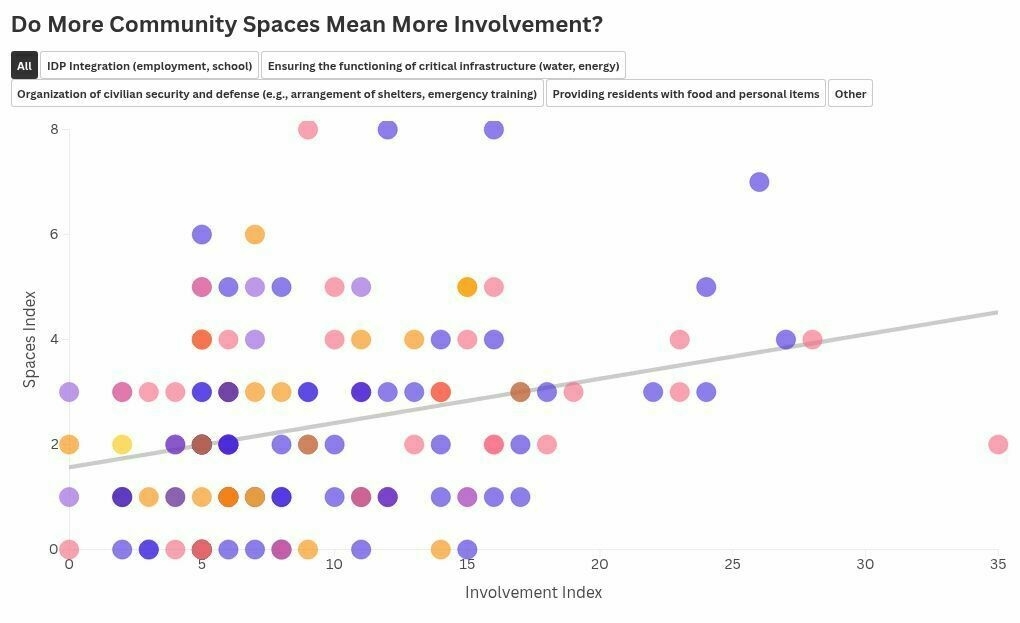
Source: Authors’ calculations. Note: The figure shows a scatter plot of the Spaces Index against the Involvement Index with category-wise trend lines (IDP integration—Spearman’s rho = 0.40 [p = <0.01]; other—Spearman’s rho = 0.23 [p = <0.05]); N = 127 (LSGs outside of combat areas, LSGs in combat areas, and liberated LSGs that engaged the public and/or business on critical issues over the last 12 months); the Involvement Index reflects the diversity of involved stakeholders in the multiplicity of participatory dimensions, while the Spaces Index demonstrates the number of community spaces reported by LSG respondents.
Conclusions and Recommendations
The Ukrainian case shows that collaborative crisis governance is both possible and effective under wartime conditions. Despite martial law, institutional disruptions, and active hostilities, many local governments have engaged civic actors—NGOs, IDPs, businesses, and veterans—not only as aid recipients but as co-producers of crisis response. This engagement has supported societal resilience by improving emergency planning, resource coordination, and local legitimacy.
To build on these strengths, three recommendations emerge:
- Treat local governments as strategic partners in national crisis management. Hromadas can provide local, context-specific solutions. To support this, Ukraine should develop formal feedback mechanisms and multi-level coordination platforms linking LSGs with oblast and central authorities.
- Make civic engagement crisis-ready. Invest in joint emergency preparedness exercises involving local officials, civic leaders, NGOs, and businesses before the next shock hits. It also requires decentralized resource stockpiling, where local actors help identify, store, and manage emergency supplies.
- Enable participation through investment in civic infrastructure. This includes safe and accessible community spaces such as bomb shelters and inclusive public centers, support for trained facilitators to guide multi-level dialogue, and outreach through new communicators—like youth groups and local NGOs—especially where local governments are overstretched.
Appendix
The Preparedness Scale is a composite measure assessing LSG crisis readiness. It includes 26 items covering resource stockpiles, crisis communication, backup infrastructure, response planning, and data security. The scale’s reliability was assessed using Cronbach’s alpha (α = 0.84), ensuring internal consistency. To facilitate interpretation, the index was normalized from 0 to 1, where higher values indicate greater preparedness.
The Involvement Scale measures stakeholder engagement in local crisis management based on the Council of Europe’s participation dimensions. It includes 35 items (α = 0.87), capturing informing, proactive, and reactive consultation, regular exchange and feedback to stakeholder input (dialogue) across the following stakeholder groups: residents, businesspeople, NGOs, IDPs, veterans, and experts. The scale is an additive index summing all stakeholder interactions, normalized to enhance comparability.
For further reading, see Keudel, O., Hatsko, V., Darkovich, A., & Huss, O. (2024). Local Democracy and Resilience in Ukraine: Learning from Communities’ Crisis Response in War (Research Report No. 33; p. 57). Swedish International Centre for Local Democracy.
[1] Valentyn Hatsko is a data analyst at the Kyiv School of Economics and a PhD candidate in sociology at Taras Shevchenko National University of Kyiv.
[2] Andrii Darkovich is a researcher and local governance expert at the Center for Sociological Research, Decentralization, and Regional Development at the Kyiv School of Economics Institute. He is pursuing a PhD in political science at the Kyiv School of Economics.
[3] Oleksandra Keudel is an associate professor at the Kyiv School of Economics. She studies democratic transformation and societal resilience in hybrid regimes, specializing in Ukraine’s subnational politics.
[4] Valentyn Hatsko, Antonii Karakai, Andrii Darkovich, Oksana Huss, Oleksandra Keudel (2024). Local Governance in Ukraine during the full-scale Russian invasion. Merged data from online surveys of local self-government authorities
[5] Congress of Local and Regional Authorities. (2023a). Baseline survey on Open Government at local level in Ukraine: Mapping initiatives and assessing needs. Council of Europe. https://rm.coe.int/open-government-surveyeng/1680a97942
[6] Congress of Local and Regional Authorities. (2023b). Survey on the needs and priorities of local authorities of Ukraine. The provision of services in times of war and post-war recovery. Council of Europe. https://rm.coe.int/1680a9f1fe
[7] Rabinovych, M., Brik, T., Darkovich, A., Savisko, M., Hatsko, V., Tytiuk, S., & Piddubnyi, I. (2023). Explaining Ukraine’s resilience to Russia’s invasion: The role of local governance. Governance, 1(20). https://doi.org/10.1111/gove.12827
Photo: depositphotos.com/ua
-
General Staff: Russia has lost 1,020,980 troops in Ukraine since Feb. 24, 2022
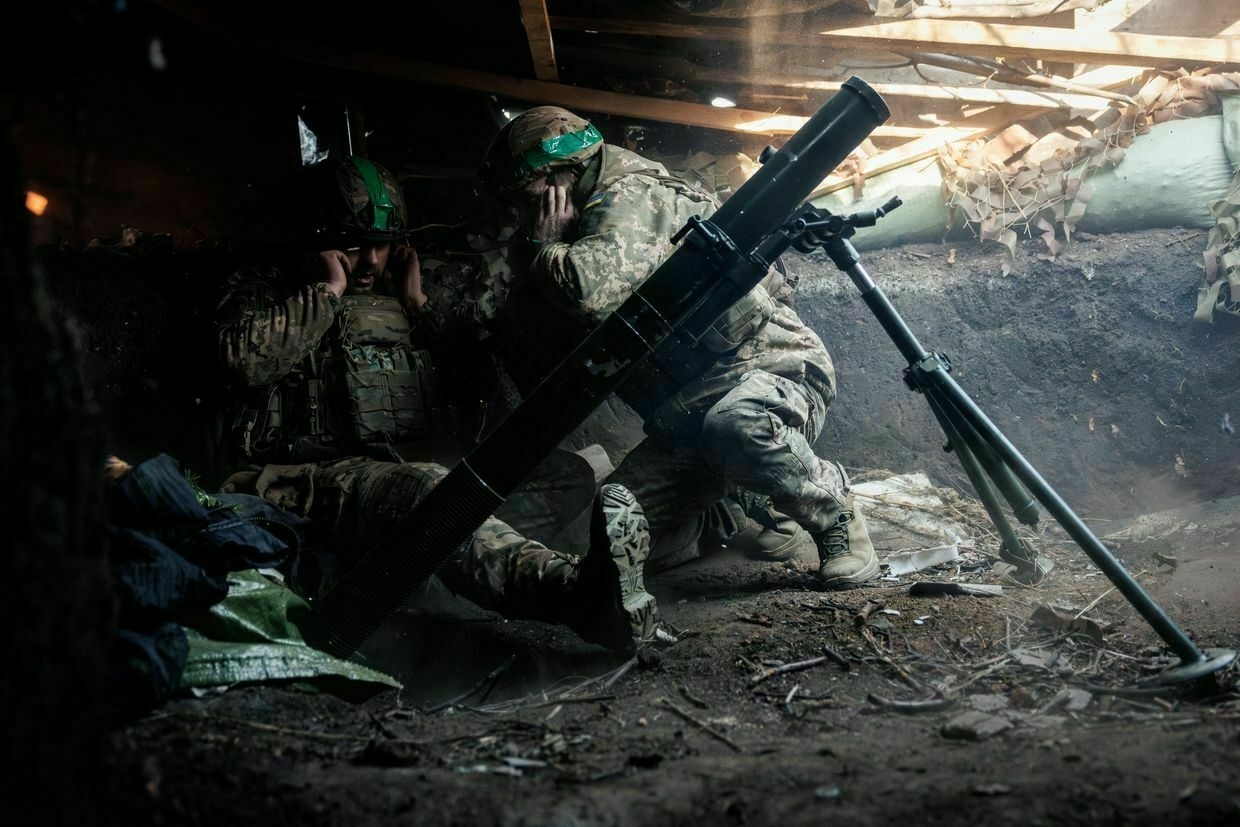
Russia has lost 1,020,980 troops in Ukraine since the beginning of its full-scale invasion on Feb. 24, 2022, the General Staff of Ukraine’s Armed Forces reported on July 1.
The number includes 970 casualties that Russian forces suffered just over the past day.
According to the report, Russia has also lost 10,983 tanks, 22,928 armored fighting vehicles, 53,696 vehicles and fuel tanks, 29,754 artillery systems, 1,427 multiple launch rocket systems, 1,190 air defense systems, 420 airplanes, 340 helicopters, 42,940 drones, 3,436 cruise missiles, 28 ships and boats, and one submarine.
Warfare in Ukraine has changed… againThe Kyiv Independent’s Francis Farrell explains a new modification of the standard first-person view (FPV) drone that already once transformed the way war is fought. Fiber optic cable now used to connect drone operators to FPVs ensures a perfect image and control experience all the way to the target — and cannot be spotted by enemy drone detectors.The Kyiv IndependentFrancis Farrell

-
Zelensky, German FM discuss supplying IRIS-T air defenses, joint weapons production, strengthening Russia sanctions
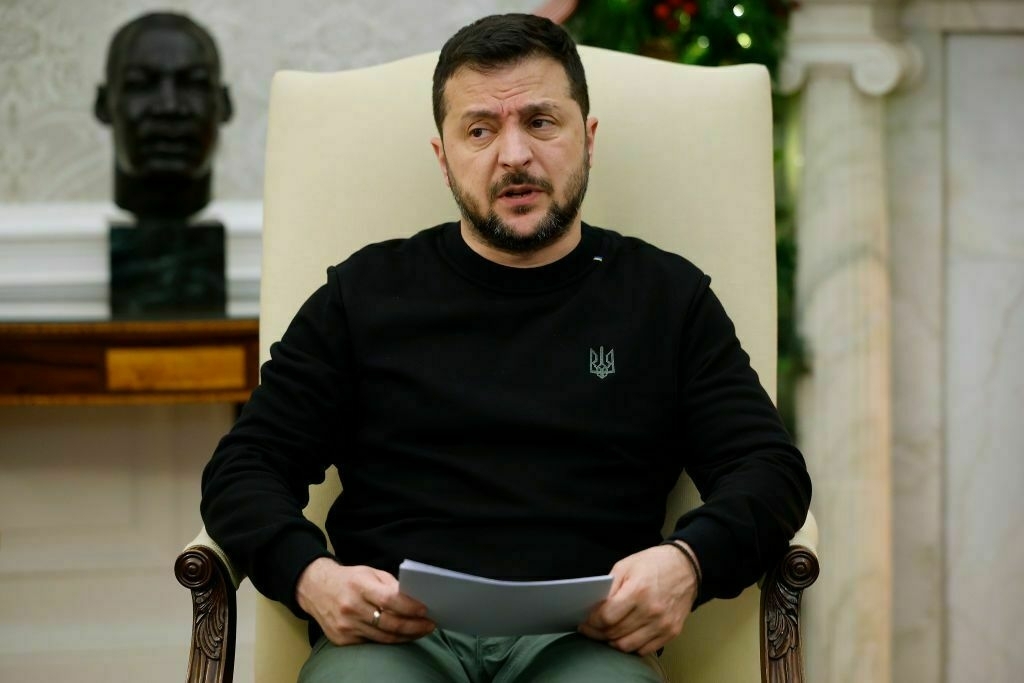
President Volodymyr Zelensky and German Foreign Minister Johann Wadephul met in Kyiv on June 30, where the two leaders discussed Germany supplying additional IRIS-T air defense systems, joint weapons production, and strengthening sanctions against Russia, Zelensky said.
Wadephul earlier said Germany is working with its defense industry, European allies, and the U.S. to secure more air defense systems for Ukraine.
“We are going down every path available… The German defense industry is trying to expand its capacity. We’re speaking with our European partners, and I believe we must also move forward with the United States,” he said.
Zelensky met with executives of German defense companies alongside Wadephul during the visit to Ukraine’s capital.
“We discussed sanctions pressure on Russia, the potential for supplying new IRIS-T systems, and joint weapons production — both in Ukraine and in Germany,” Zelensky said in a post to social media.
Zelensky noted Germany signalled it believes that Ukraine’s future is in NATO amid Russia’s war against Ukraine.
“We will continue to develop relevant military hubs and increase the presence of German companies in Ukraine. We had an in-depth discussion on interceptor drones. I am grateful for the willingness to help,” Zelensky said.
Earlier in the visit, Wadephul noted that he remains in close contact with German Defense Minister Boris Pistorius to assess whether existing systems from Germany’s own stockpiles can be redirected to Ukraine.
Loss of Ukraine lithium deposit to Russia won’t impact minerals deal, says investorRussian troops have taken over the site of one of Ukraine’s most valuable lithium deposits near the village of Shevchenko, Donetsk Oblast, as Russia ramps up its summer offensive. While Ukrainian troops control territories near the site, the deposit is now under Russian occupation, Roman Pohorilyi, founder of open-sourceThe Kyiv IndependentDominic Culverwell
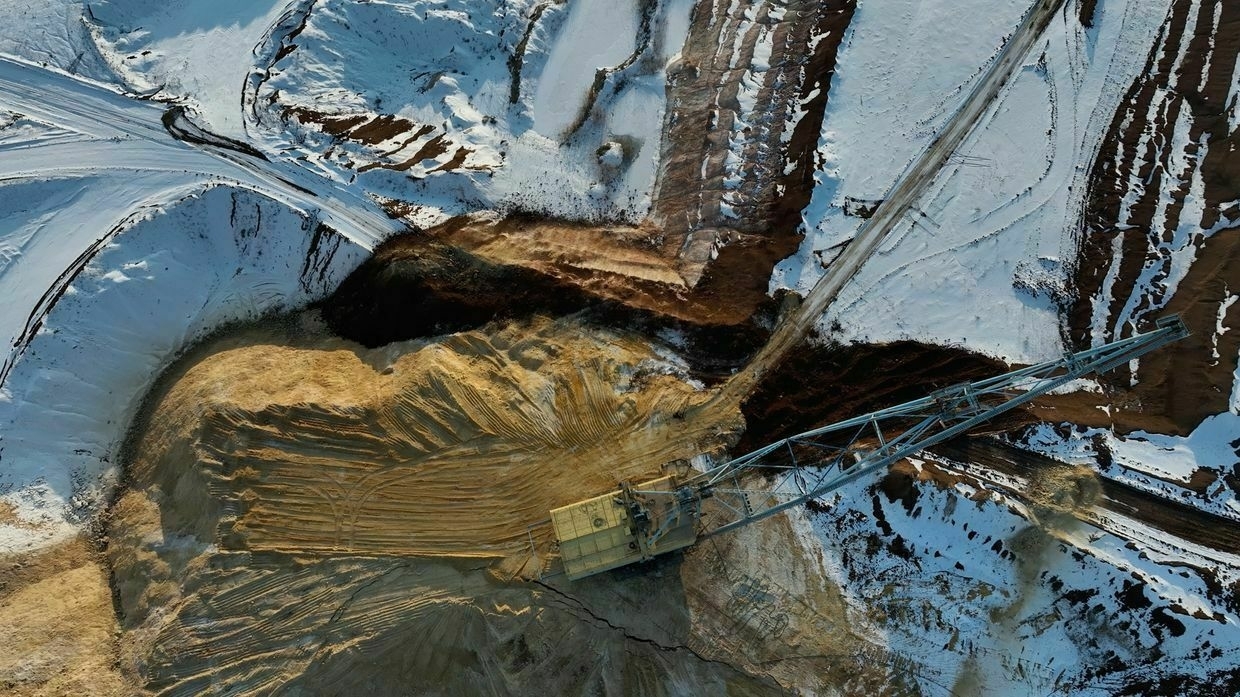
-
UN analysis finds Russia responsible for 2022 Olenivka prison explosion killing Ukrainian POWs, ombudsman says
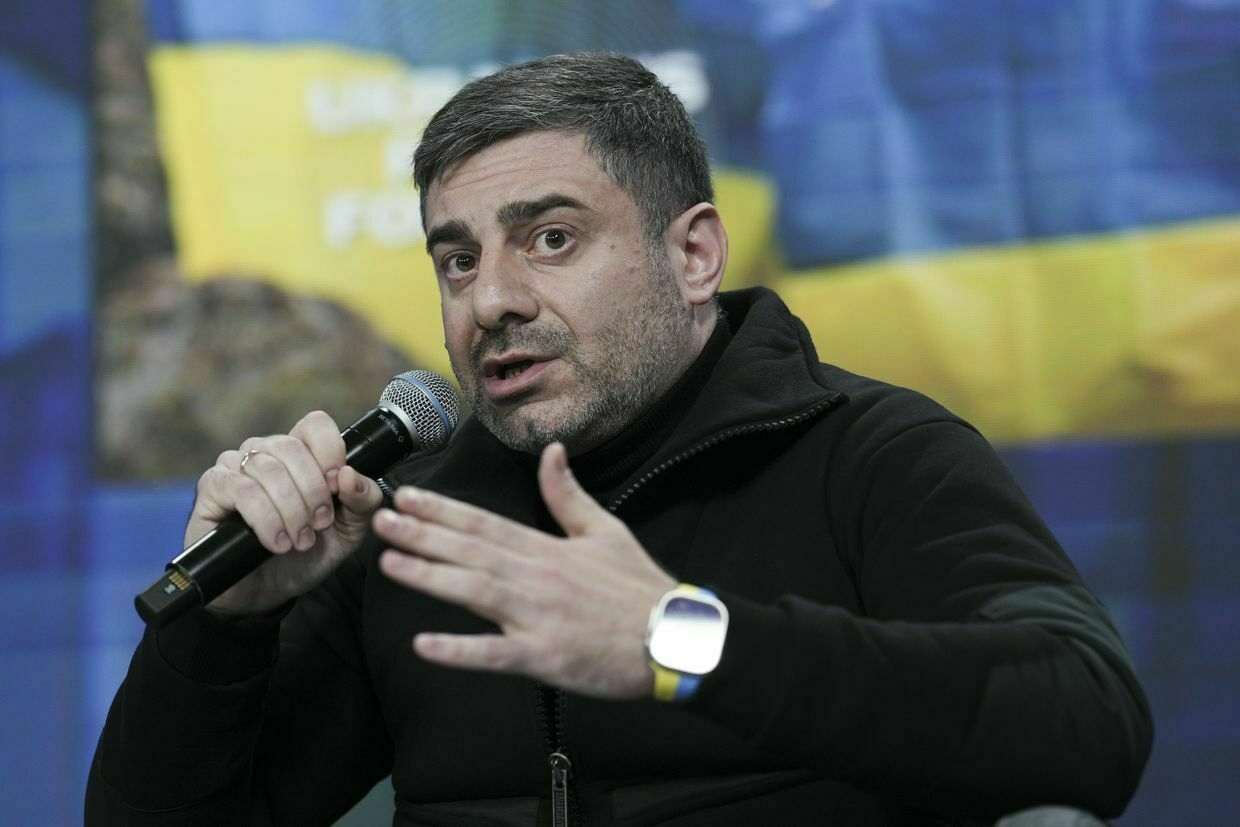
A United Nations (UN) internal analysis has found Russia responsible for a 2022 explosion at Olenivka prison, which killed over 50 Ukrainian prisoners of war (POWs), Ombudsman Dmytro Lubinets said on June 30.
"(A)n internal analysis of the UN showed that it was the Russian Federation that planned and carried out the attack," he said in a post to social media.
Russia has denied responsibility, prevented efforts by the international community to independently investigate the attack, and contaminated evidence at the site, according to a report published by the UN.
Kyiv has said that days before the July 2022 attack, Russia deliberately put Ukrainian members of the Azov Regiment, who were awaiting a prisoner exchange, in a separate part of the Olenivka prison building that was later destroyed in the explosion.
“The report identifies the weapons and ammunition that the Russian Armed Forces used to kill Ukrainian prisoners of war, and also examines in detail the planning, organization, and execution of the murder,” Lubinets said.
The ombudsman noted that the UN fact-finding mission on Olenivka was disbanded due to a lack of security guarantees, adding that the mission has previously refused to review evidence provided by Ukraine.
Russia has repeatedly violated international conventions protecting the rights of POWs as it continues to carry out its war against Ukraine.
A Russian military court has convicted 184 Ukrainian POWs captured in Kursk Oblast of acts of terrorism, Mediazona reported on June 25.
The POWs captured in Kursk were charged with carrying out a grave terrorist act by a group of individuals, as outlined by the Russian Criminal Code.
Junior Lieutenant Yevhen Hoch was convicted of allegedly carrying out an act of terrorism by taking part in Ukraine’s Kursk Oblast incursion.
Smashing previous monthly record, Russia launches 5,337 kamikaze drones against Ukraine during JuneRussia launched a record 5,337 Shahed-type drones against Ukraine in June, according to data from the Ukrainian Air Force and Dragon Capital, smashing the previous record of 4,198 set in March. Russia’s bombardments, a fact of life after three years of full-scale war, have intensified dramatically in MayThe Kyiv IndependentYuliia Taradiuk
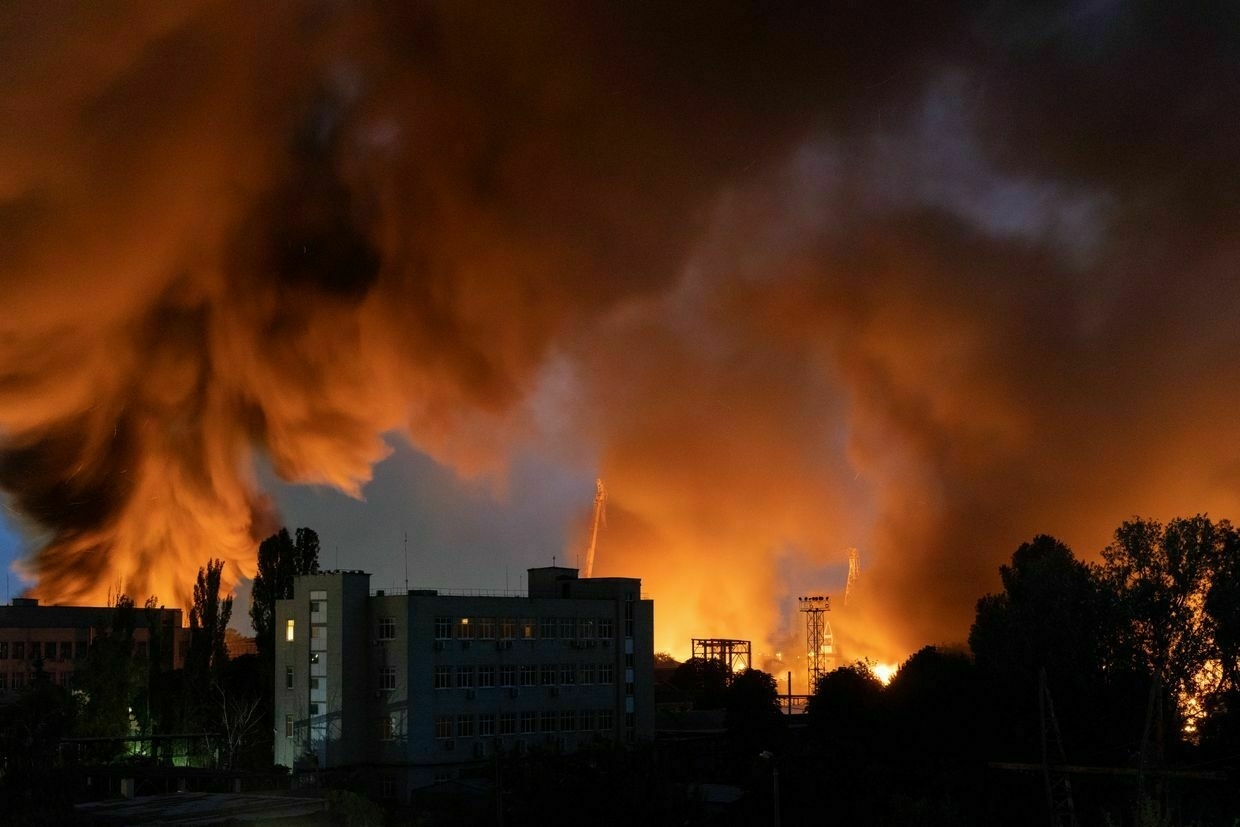
-
Russian logistics hub burning in occupied Luhansk Oblast amid reported drone attack, explosions
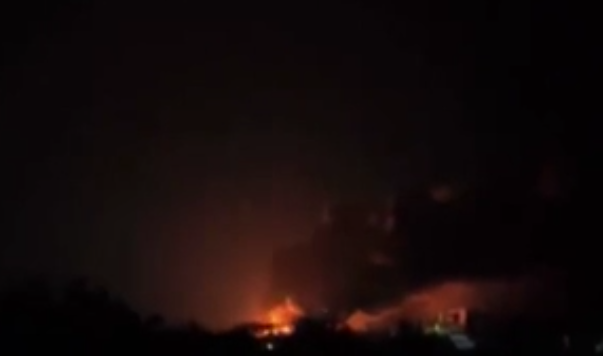
Editor’s note: This is a developing story and is being updated.
A Russian logistics hub in occupied Luhansk Oblast is on fire amid a reported drone attack overnight on July 1.
“Russian logistics in temporarily occupied Luhansk are burning,” head of the center for disinformation Andriy Kovalenko said.
The drone attack was reported by local media, publishing what appear to be videos of the burning logistics hub and the sound of drones.
Russian state media reported that over 20 drones were flying over Luhansk Oblast, citing Russian proxies in the region.

Ukraine’s Luhansk Oblast (Nizar al-Rifai/The Kyiv Independent) Ukraine’s military regularly strikes military targets in Russian-occupied territories and deep within Russia in an attempt to diminish Moscow’s fighting power as it continues its war against Ukraine.
Ukraine’s military intelligence (HUR) destroyed three Russian air defense systems using drones in the occupied Zaporizhzhia Oblast on June 14.
“Strike drone masters of the Department of Active Operations of the HUR of the Ukrainian defense ministry discovered and destroyed expensive air defense systems of the Russian invaders in the temporarily occupied territory of the Zaporizhzhia region,” HUR reported in a post to Telegram.
A Russian Buk-M3, a Pantsyr S1, and a 9S19 Imbir radar from the S-300V air defense system were destroyed in the Ukrainian drone attack.
Ukraine war latest: Ukrainian forces push Russian army away from SumyKey developments on June 30: * Ukrainian forces push Russian army away from Sumy, General Staff says * Ukrainian military again denies reports on Russian troops entering Dnipropetrovsk Oblast * After months of stalling, Russia blames Ukraine, US for slow pace of peace talks * Germany vows to pursue ‘every path’ to boost Ukraine’sThe Kyiv IndependentThe Kyiv Independent news desk

-
Ukraine launches missile attack against Crimea, Donetsk and Rostov
Ukraine has reportedly launched a missile attack on Crimea and Donetsk, with several missiles reportedly heading towards Novoshakhtinsk in Russia's Rostov region. A missile strike threat has been declared near Akhtubinsk, close to the Kapustin Yar military base.
Russian Telegram channel "Incident Sevastopol" reports that approximately nine Ukrainian fighter jets launched cruise missiles. Footage of the launches has been captured in the Kherson region. The Russian channel 13 TACTICAL noted that multiple missiles flew towards Dzhankoy, Novoshakhtinsk, and even German Taurus missiles towards Rostov.
Germany had planned to supply Taurus missiles to the Ukrainian Armed Forces. Sevastopol’s military units have sounded alarms, and an explosion has been reported in the Krasnoperekopsky district.
Vehicle traffic on the Kerch Bridge has been halted, according to the monitoring channel "Crimean Wind." In Novoaleksiivka, Kherson region, near the peninsula border, a missile was reportedly heard flying overhead at 21:40. Russian Telegram channels report British Storm Shadow missile sightings over northern Crimea and towards Russia's Rostov region.
Russian military channels reported explosions in Donetsk and Yasynuvata. Eyewitnesses in the city center reported seeing smoke.
Preliminary reports suggest Ukrainian Air Forces targeted a metallurgical plant in Donetsk and a railway station in Yasynuvata. It was later reported that the headquarters of the 8th Combined Arms Army of Russia, located in Donetsk’s central department store, was hit. The Ukrainian Command has not commented on the missile strikes on occupied Donbas and Crimea.
A missile alert has also been issued in Akhtubinsk, Astrakhan region. The city's mayor, Alexander Sivakov, urged residents to stay indoors, avoid large crowds, and monitor official information closely. Akhtubinsk houses an airport of the same name. The nearby Kapustin Yar missile range in the Astrakhan region was previously used by Russia to launch medium-range ballistic missiles known as "Oreshnik."
The distance from the frontlines to Akhtubinsk and the range is over 600 kilometers. As of late May, reports estimated that the Ukrainian Armed Forces could have around 40 sets of ATACMS missiles remaining. The UK and Germany are working on producing new weapons capable of long-range and precision strikes, with a target range exceeding 2,000 kilometers.
-
UN report reveals Russia's premeditated attack on Olenivka prison, debunking Ukrainian HIMARS claims
In a stunning revelation, a United Nations expert group has issued a report based on an internal analysis concluding that Russia orchestrated and executed the attack on Olenivka prison. This damning finding identifies the Kremlin's deliberate targeting of Olenivka Correctional Colony No. 120 in Volnovakha on the night of July 28 to 29, 2022. The atrocity left more than 50 Ukrainian prisoners of war dead and around 130 injured, reported Ukrainian Ombudsman Dmytro Lubinets on his Telegram channel.
Following the explosion, Russia hastily blamed Ukraine, alleging a supposed "HIMARS missile attack." While the International Committee of the Red Cross and the UN expressed a willingness to investigate the horrifying incident, the UN's Olenivka fact-finding mission was dissolved five months later, citing insufficient safety assurances.
"Despite repeated attempts to meet with UN mission members to provide evidence held by Ukraine, they never agreed to review it. I even extended an invitation for a joint visit to the scene with the Russian human rights commissioner, but received a rejection," Lubinets lamented. It took a full year for the UN to debunk Russia’s falsehoods by stating the Olenivka attack "was not caused by a HIMARS rocket!" Nevertheless, Lubinets noted, the UN has yet to publicly accuse Russia of terrorism, even with evidence in hand.
"Recently, however, a UN expert group independently published a detailed report with evidence - an internal UN analysis that identified Russia as the planner and perpetrator of the attack. The report specifies the weapons and ammunition deployed by Russian armed forces to execute the massacre of Ukrainian prisoners of war and thoroughly examines the planning, organization, and execution of the killings. It also evaluates the investigations conducted by Russia, Ukraine, and the UN itself, offering forward-looking recommendations for Ukraine," Lubinets concluded.
On July 29, 2022, authorities of the so-called Donetsk People’s Republic reported that 47 people perished and 75 were injured, including eight guards, during the shelling of the penal colony.
Later, the Ukrainian General Staff reported that Russian armed forces carried out a targeted, premeditated artillery strike on the detention facility in Olenivka.
-
EU seals new trade deal with Ukraine, key details still pending
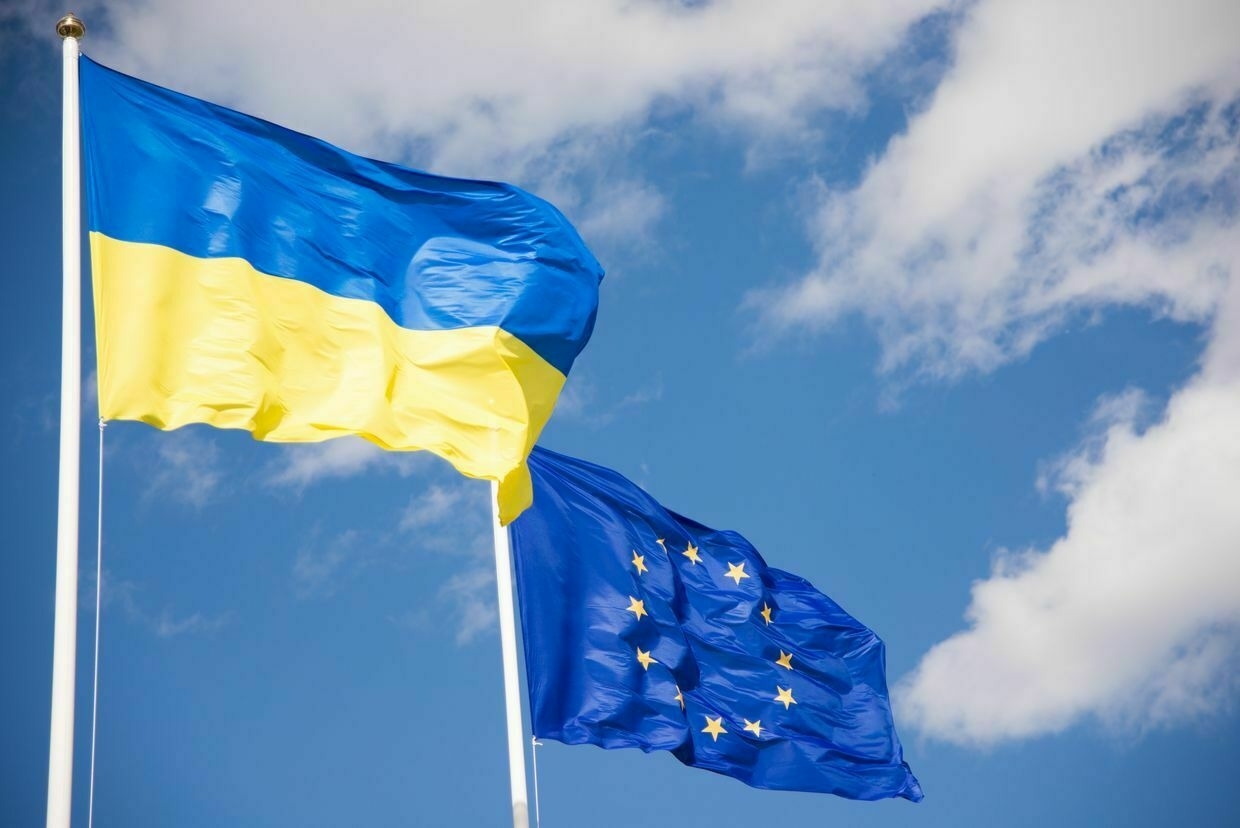
The European Union has reached a long-term trade agreement with Ukraine, marking the end of wartime trade liberalisation measures, though key details of the deal remain undisclosed.
EU Trade Commissioner Maros Sefcovic and Agriculture Commissioner Christophe Hansen announced the agreement on June 30, calling it a “predictable” and “reciprocal” framework. However, they did not reveal the final quotas or volumes included in the deal. Sefcovic noted that the finer points would be finalised “in the coming days.”
The new deal replaces the autonomous trade measures (ATMs) that allowed Ukrainian agri-food exports to enter the EU tariff-free since 2022. Those temporary measures expired on June 5, reinstating pre-war trade conditions for a brief period.
Structured in three tiers, the new framework introduces modest increases in quotas for products considered sensitive by EU member states, such as eggs, poultry, sugar, wheat, maize, and honey. A second group of products—including butter, skimmed milk powder, oats, barley, malt, and gluten—will see their quotas adjusted to reflect peak import levels reached since the start of the war. A third category, which includes items such as whole milk powder, fermented milk, mushrooms, and grape juice, will be fully liberalised.
Once finalised, the text of the agreement will be submitted to the Council for ratification.
Sefcovic said negotiations concluded over the weekend, less than a month after formal talks began. However, some critics claim the EU delayed the process to avoid backlash from farmers ahead of Poland’s presidential election.
The agreement also benefits EU producers, granting them greater access to the Ukrainian market for goods like pork, poultry, and sugar. But Hansen made it clear that expanded access for Ukrainian exports will depend on Ukraine’s compliance with EU agricultural standards by 2028, including rules on animal welfare and pesticide use. “This commitment also fits perfectly with Ukraine’s EU accession path,” he said.
The deal includes safeguard provisions, allowing the EU or individual member states to restrict imports if domestic markets face serious disruptions. “Both EU and Ukrainian producers deserve a stable and predictable basis for the future development of bilateral trade,” Hansen added.
Smashing previous monthly record, Russia launches 5,337 kamikaze drones against Ukraine during JuneRussia launched a record 5,337 Shahed-type drones against Ukraine in June, according to data from the Ukrainian Air Force and Dragon Capital, smashing the previous record of 4,198 set in March. Russia’s bombardments, a fact of life after three years of full-scale war, have intensified dramatically in MayThe Kyiv IndependentYuliia Taradiuk
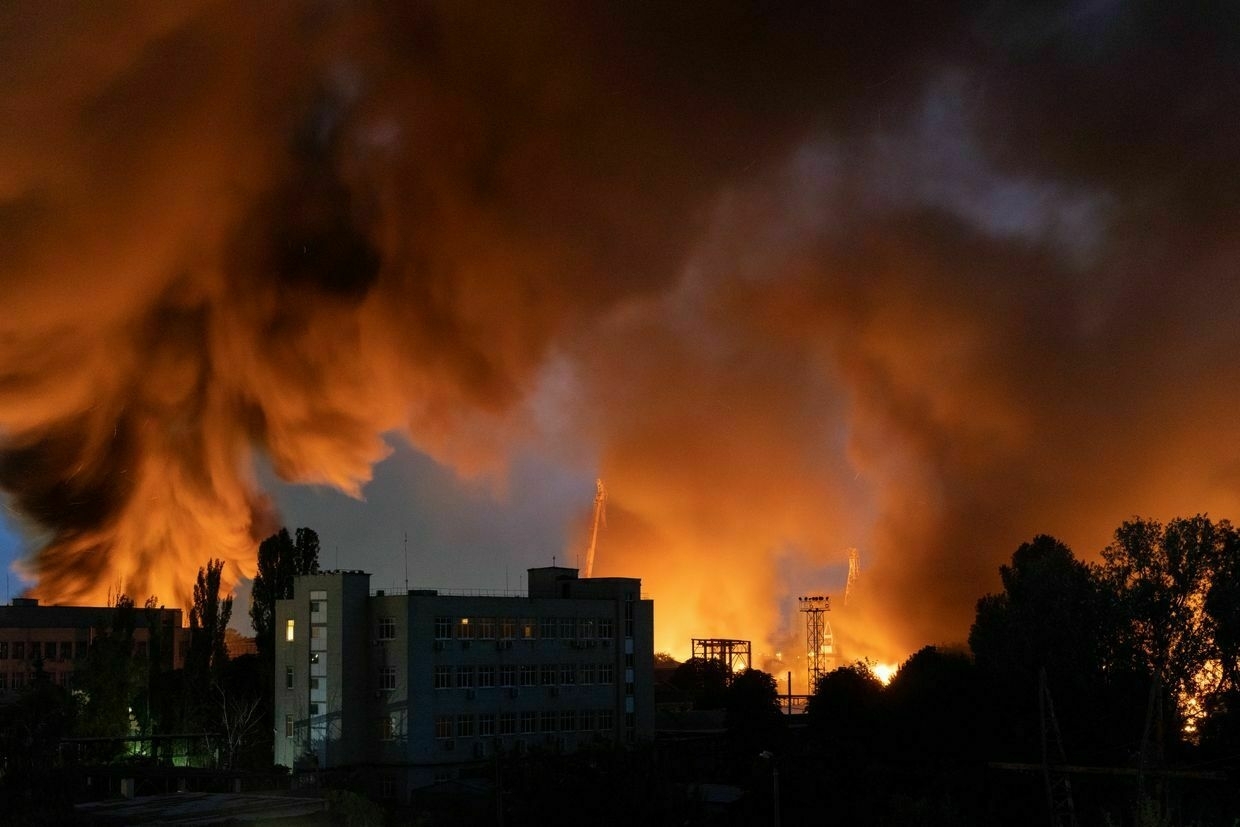
-
'Russia cannot continue to stall for time' while bombing Ukrainian civilians, Kellogg says
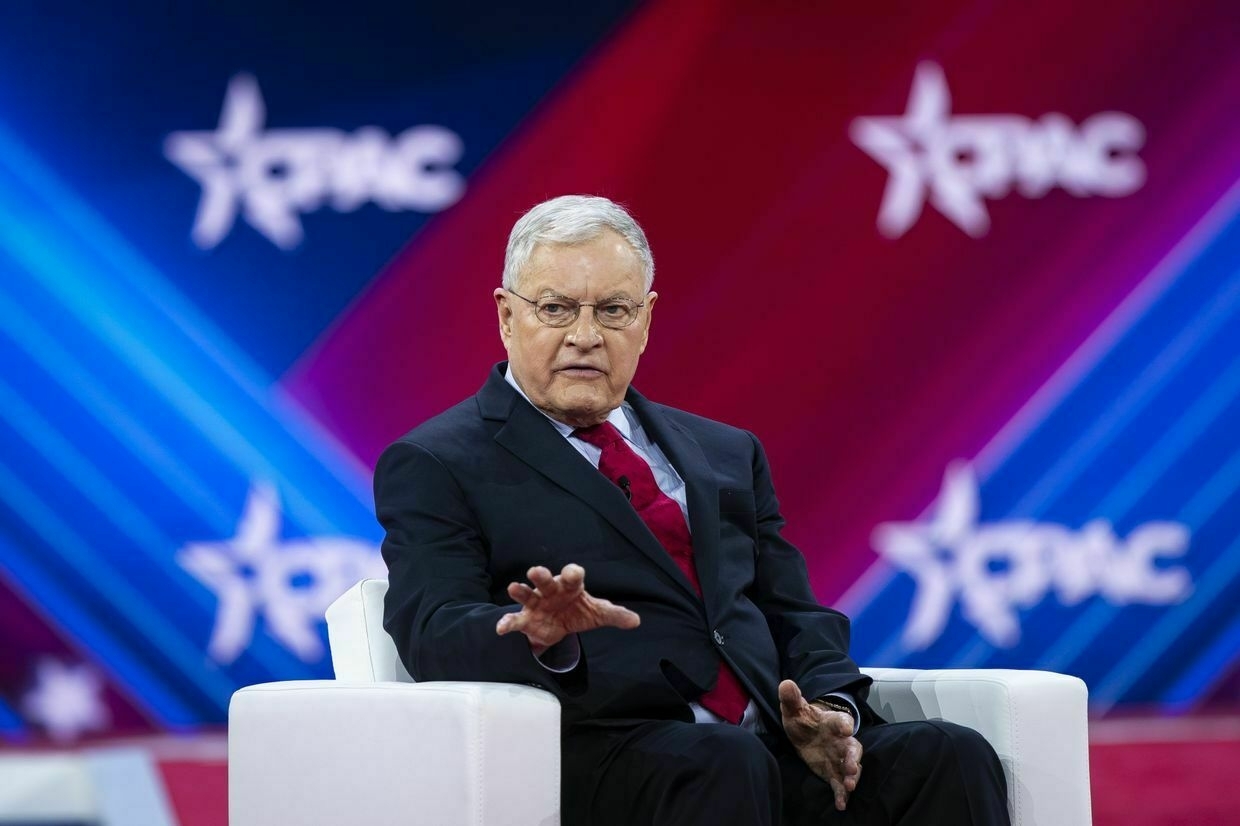
U.S. Special Representative Keith Kellogg has pushed back against Russian claims that Ukraine and the United States are responsible for delaying peace negotiations, arguing that it is Moscow that continues to obstruct efforts to end the war it initiated.
“Peskov’s recent comments on the state of negotiations are Orwellian. Russian claims that it is the US and Ukraine stalling peace talks are unfounded. President Trump has been consistent and adamant about making progress to end the war. We urge an immediate ceasefire and a move to trilateral talks to end the war. Russia cannot continue to stall for time while it bombs civilian targets in Ukraine,” Kellogg said on X.
Kremlin spokesperson Dmitry Peskov on June 29 accused Washington and Kyiv of holding up progress, stating that future developments in peace talks depend on Ukraine’s stance, the effectiveness of U.S. mediation, and the situation on the battlefield.
“A lot depends, naturally, on the position of the Kyiv regime,” Peskov said in a televised interview with Belarus 1 TV, according to Reuters. “It depends on how effectively Washington’s mediating efforts continue,” he added.
Despite those remarks, Russia has rejected a U.S.-backed ceasefire proposal and continued its attacks on Ukrainian cities launching record numbers of drones against Ukrainian cities. Earlier this month, Russian President Vladimir Putin openly stated that “all of Ukraine is ours,” raising further doubts about the Kremlin’s willingness to engage in meaningful negotiations.
Peskov’s interview aired as the war moves into its fourth summer with no comprehensive ceasefire in place. Although two rounds of peace talks between Russia and Ukraine took place in Istanbul this year—on May 16 and June 2—the discussions have not led to any breakthrough on ending hostilities.
While the Istanbul meetings led to notable prisoner exchanges, they produced no tangible progress toward peace.
Smashing previous monthly record, Russia launches 5,337 kamikaze drones against Ukraine during JuneRussia launched a record 5,337 Shahed-type drones against Ukraine in June, according to data from the Ukrainian Air Force and Dragon Capital, smashing the previous record of 4,198 set in March. Russia’s bombardments, a fact of life after three years of full-scale war, have intensified dramatically in MayThe Kyiv IndependentYuliia Taradiuk
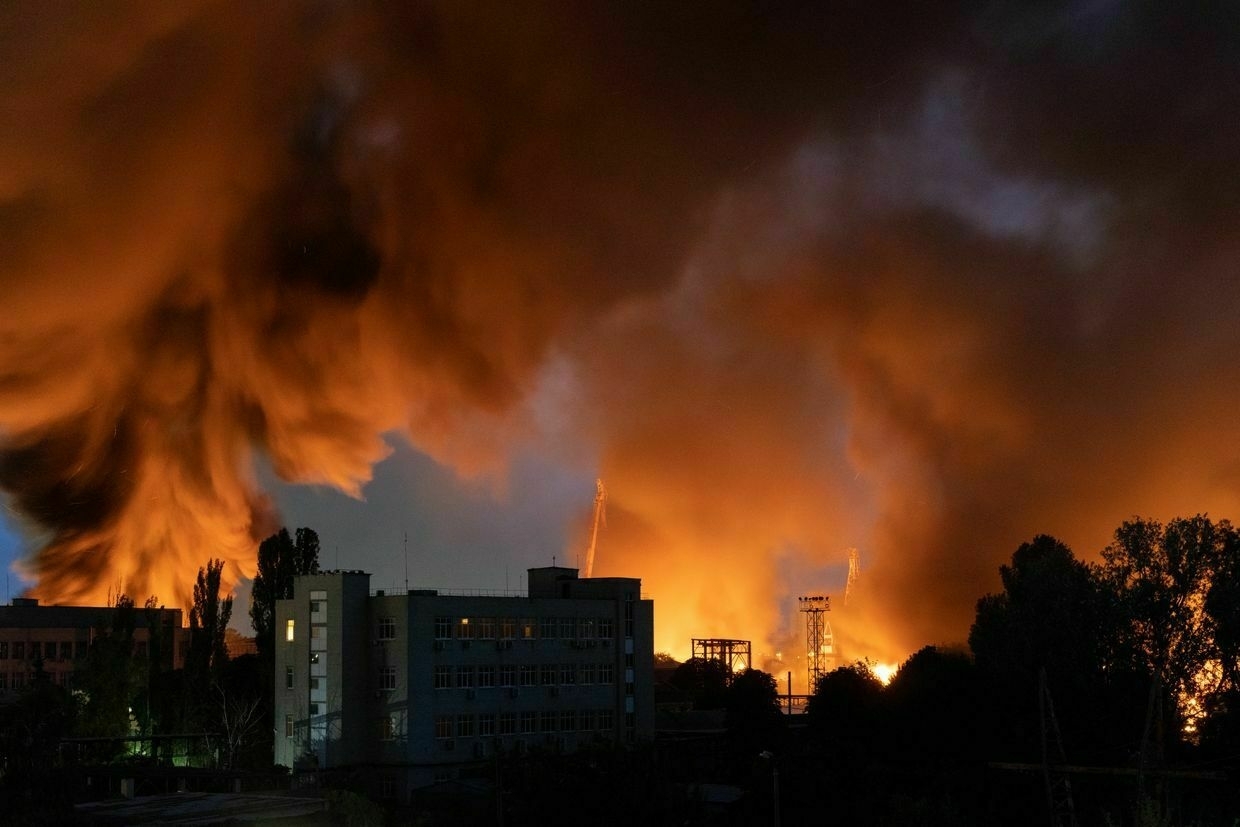
-
Oil tanker damaged by blast weeks after visiting Russian ports, Bloomberg reports
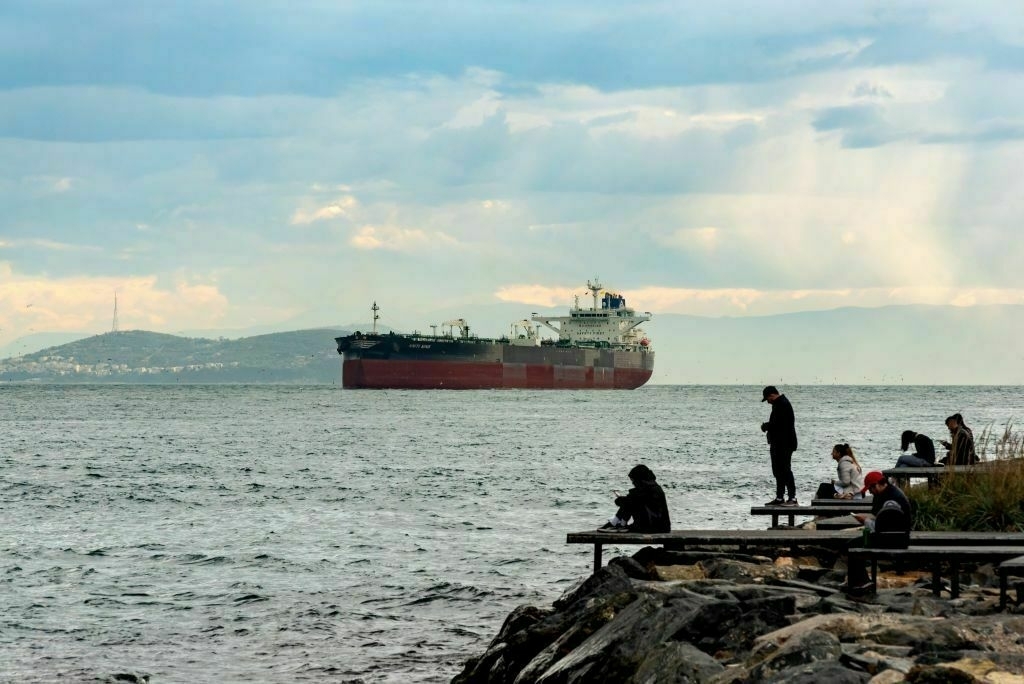
A tanker carrying 1 million barrels of oil experienced an explosion near Libya, its operator TMS Tankers said on June 30. The vessel, Vilamoura, is now being towed to Greece, where the extent of the damage will be assessed upon arrival.
The blast caused the engine room to flood due to water intake, though the cause of the explosion remains unclear, according to a company spokesperson.
The spokesperson confirmed that the crew is safe and no pollution has been reported. The incident comes amid a series of unexplained blasts targeting oil tankers that had previously visited Russian ports. In response, shipowners have started inspecting their vessels for mines using divers and underwater drones.
Vilamoura had visited Russian oil terminals twice since April, loading Kazakh-origin crude rather than Russian oil. According to Bloomberg vessel-tracking data, the tanker called at the Russian port of Ust-Luga in early April and at the Caspian Pipeline Consortium (CPC) terminal near Novorossiysk in May. Both terminals primarily handle Kazakh crude exports.
Maritime risk consultancy Vanguard Tech reported that four other vessels have been damaged by explosions since the beginning of the year. Each had recently docked at Russian ports, the firm said.
Ukraine has targeted Russian energy assets throughout the full-scale invasion, including a drone strike in February on the CPC pipeline, a route responsible for moving roughly 80% of Kazakhstan’s oil exports.
-
Not only the Chinese! Ukrainian fighters captured mercenaries from Cameroon #shorts
-
Loss of Ukraine lithium deposit to Russia won’t impact minerals deal, says investor
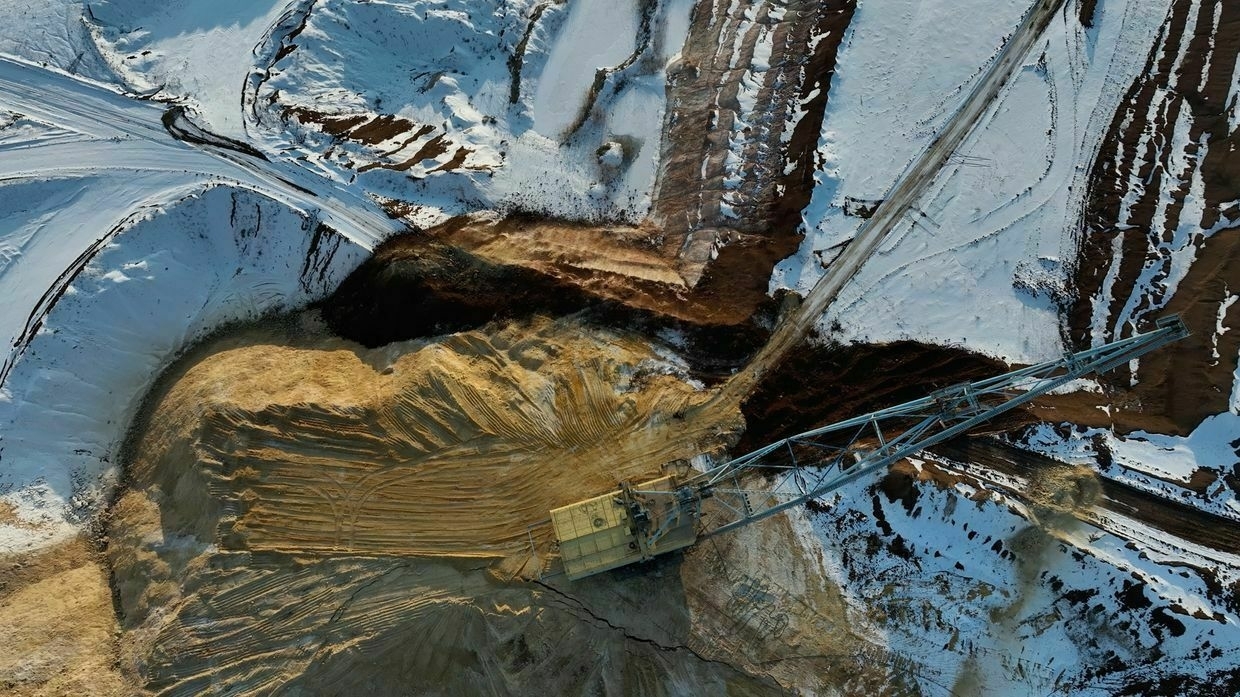
Russian troops have taken over the site of one of Ukraine’s most valuable lithium deposits near the village of Shevchenko, Donetsk Oblast, as Russia ramps up its summer offensive.
While Ukrainian troops control territories near the site, the deposit is now under Russian occupation, Roman Pohorilyi, founder of open-source mapping project Deep State Map, told the Kyiv Independent.
Ukraine’s military said its forces are continuing to fight around the village, with Ukrainian forces on the western outskirts and Russian forces on the eastern side, Viktor Trehubov, the spokesperson for Ukraine’s Khortytsia group of forces, told the Kyiv Independent. The untapped 40-acre plot lies less than two kilometers east of the village.
“There are active hostilities. They are ongoing across the entire section, across all of the Novopavlivka (front),” Trehubov said.Lithium, used in electric vehicle batteries, is one of the key critical raw materials highlighted by the U.S. in the agreement that was signed on April 30.
The reported Russian takeover of the deposits comes just two months after Ukraine signed a landmark critical minerals agreement with the U.S. to attract investment to the war-torn country, particularly to its strategic resources, including its untapped lithium reserves.
But despite Ukraine's apparent loss of the deposit, it is unlikely to have an impact on the agreement, Serhii Fursa, deputy managing director at investment firm Dragon Capital, told the Kyiv Independent.
“It was obvious that it was under huge risk of occupation and nobody assumed it would be a good asset for any kind of deal,” Fursa said.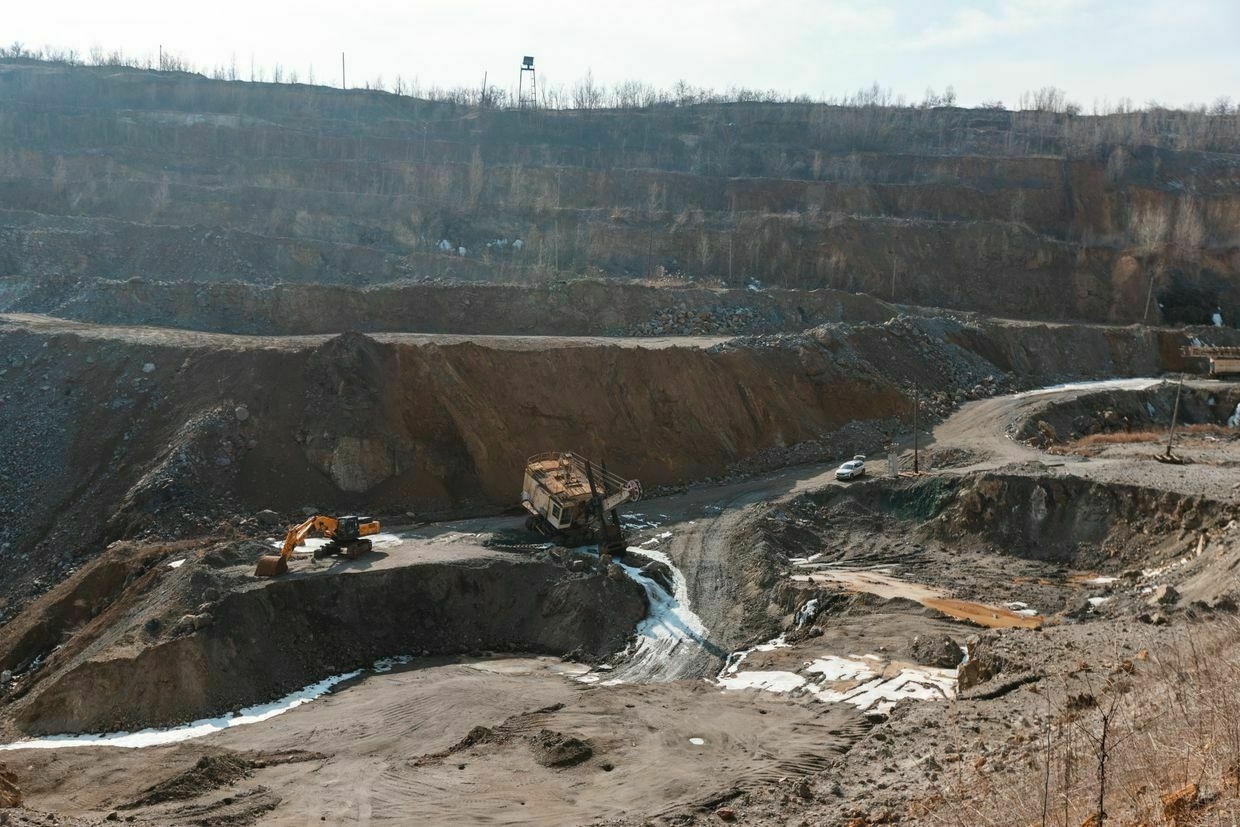
View of the Zavalivskyi graphite quarry in Zavallia, Kirovohrad Oblast, Ukraine, on Feb.28, 2025. The plant produces about 10 types of graphite for applications ranging from brake pads to lithium-ion batteries. (Arsen Dzodzaiev / Global Images Ukraine via Getty Images) The Kyiv Independent reached out to Ukraine's Ecology Ministry to confirm the site had been taken, but the ministry did not return the request for comment by the time of publication. The Economy Ministry also did not reply to a request for comment on the economic fallout of losing the deposits.
Ukraine now has only two out of four lithium deposits left, both in central Ukraine. Russian forces occupied the Kruta Balka deposit in Zaporizhzhia Oblast in the first year of the full-scale invasion.
Lithium, used in electric vehicle batteries, is one of the key critical raw materials highlighted by the U.S. in the agreement that was signed on April 30. Kyiv initially wanted Washington to promise security guarantees as part of the deal, but after protracted negotiations that threatened to tarnish U.S.-Ukraine relations, guarantees were not included.
Kyiv is planning to open up the large Dobra lithium field in central Ukraine, containing between 80-105 million metric tons of lithium ore, to private investors, marking the first project under the agreement.
The Shevchenko deposit is smaller, with an estimated volume of 11 to 14 million tons of ore, according to the mining company European Lithium, which previously held the license to mine the deposit. The ore is unique in Ukraine as it contains 90% spodumene, a mineral rich in lithium, making it easy to extract.European Lithium never mined the Shevchenko deposit and in 2023 said it no longer laid claim to it, citing its proximity to the front line.
Initially, Russia claimed to have captured Shevchenko as clashes intensified in the region amid Russia’s summer offensive on June 26. The following day, the New York Times reported that the lithium deposit had been captured, although Khortytsia told the Kyiv Independent that Russian forces had not yet captured the village.
Ukraine is one of the few European countries to have high deposits of lithium and holds one-third of the European Union's reserves and approximately 3% of global lithium reserves, according to the Kyiv School of Economics.
Demand for lithium is growing, with Australia and China topping the list of producers.
Ukraine, US plan to launch minerals investment fund by year’s end“We discussed very concrete steps how to make this fund operational during this year,” Ukrainian Economy Minister Yulia Svyrydenko said during a visit to Washington.The Kyiv IndependentTim Zadorozhnyy
 Subscribe to the NewsletterUkraine Business Roundup
Subscribe to the NewsletterUkraine Business Roundup<span data-sanitized-id="ukraine-business-roundup-info" data-sanitized-class="ukraineBusinessRoundup__info"></span> <button data-sanitized-id="ukraine-business-roundup-subscribe-btn" data-sanitized-class="ukraineBusinessRoundup__form_button"> <span data-sanitized-class="ukraineBusinessRoundup__form_label">Subscribe</span> </button> </div>